
219-00074 or equivalent

219-00024 or equivalent

NUD105-R025D or equivalent

014-R1072 or equivalent

176-R032A or equivalent

216-00001 or equivalent

SGT27000 or equivalent 250-300 mA incandescent bulb test lamp
SECTION 412-00: Climate Control System — General Information and Diagnostics
| 2014 Flex Workshop Manual
|
DIAGNOSIS AND TESTING
| Procedure revision date: 05/02/2013
|
 | A/C Flush Adapter Kit
219-00074 or equivalent |
 | A/C Flush and Purge Fitting Kit
219-00024 or equivalent |
 | Flex Probe Kit
NUD105-R025D or equivalent |
 | Pressure Test Kit
014-R1072 or equivalent |
 | R-134a Manifold Gauge Set
176-R032A or equivalent |
 | Refrigerant Leak Detector
216-00001 or equivalent |
 | Test Light
SGT27000 or equivalent 250-300 mA incandescent bulb test lamp |
Principles of Operation
For additional refrigerant system and component information, refer to Section 412-01 .
Climate Control System Network Communication
The controls for the climate control system are in one or more locations depending on vehicle option content:
When the FDIM touchscreen or voice commands are used, the APIM sends a function request message over the I-CAN to the FCIM .
When the IPC steering wheel controls are used, the IPC sends a function request message over the I-CAN to the FCIM .
The FCIM receives the climate control selections from pressing the buttons on its own controls (interface), the APIM or IPC and sends the requests to the HVAC module in the following message path:
For EMTC systems, the messaging path is followed in reverse for any status updates that need to be sent from the HVAC module to the FCIM , then if applicable, to the IPC or FCDIM (through the APIM ).
For DATC systems, the messaging path is followed in reverse for any status updates that need to be sent from the HVAC module to the FCIM , FCDIM (non-touchscreen), FDIM (through the APIM ) and IPC message center.
Climate Control System Logic
When blower speed is selected, the FCIM sends the desired blower speed to the HVAC module using the message path described above. The HVAC module then commands the blower motor speed control to the desired speed. The HVAC module monitors the blower motor speed control feedback circuit to make sure the blower motor is at the desired speed.
When an airflow mode is selected, the FCIM determines the applicable and allowable airflow direction. The FCIM then sends this desired airflow direction to the HVAC module using the message path described above. The HVAC module determines the actuator position required to deliver the correct airflow direction. While monitoring the defrost/panel/floor feedback circuit, the HVAC module drives the actuator until the feedback circuit indicates the actuator has reached its required position.
When a temperature is selected, the FCIM sends the desired temperature selection to the HVAC module using the message path described above. The HVAC module then determines the temperature blend door desired position. While monitoring the temperature blend door feedback circuit, the HVAC module drives the actuator until the feedback circuit indicates the actuator has reached its desired position.
When fresh air or RECIRC mode is selected, the FCIM sends the desired selection to the HVAC module using the message path described above. The HVAC module drives the air inlet mode door actuator until the HVAC module detects the actuator reached its end of travel. A spike in current draw tells the HVAC module the actuator has reached the end of its travel.
When A/C is selected, the FCIM sends the selection to the HVAC module using the message path described above. If the ambient air temperature is sufficient, the HVAC module then sends the request to the BCM over the MS-CAN . The BCM then sends the request to the PCM over the HS-CAN .
FET Protection
A FET is a type of transistor that, when used with module software, monitors and controls current flow on module outputs. The FET protection strategy prevents module damage in the event of excessive current flow.
The HVAC module utilizes a FET protective circuit strategy for its actuator outputs. Output load (current level) is monitored for excessive current (typically short circuits) and shuts down (turns off the voltage or ground provided by the module) when a fault event is detected. A short circuit DTC is stored at the fault event and a cumulative counter is started.
When the demand for the output is no longer present, the module resets the FET circuit protection to allow the circuit to function. The next time the driver requests a circuit to activate that has been shut down by a previous short ( FET protection) and the circuit is still shorted, the FET protection shuts off the circuit again and the cumulative counter advances. If excessive circuit load occurs repeatedly, the module shuts down the output until a repair procedure is carried out.
When each tolerance level is reached, DTC U1000:00 should set (U1000:00 may or may not set) along with the short circuit DTC that was stored on the first failure. These DTCs cannot be cleared by a command to clear the DTCs. The module does not allow the DTC to be cleared or the circuit to be restored to normal operation until a successful self-test proves the fault has been repaired. After the self-test has successfully completed (no on-demand DTCs present), DTC U1000:00 and the associated DTC (the DTC related to the shorted circuit) automatically clears and the circuit function returns.
The module never resets the fault event counter to zero and continues to advance the fault event counter as short circuit fault events occur. If the number of short circuit fault events reach the third level, DTC U3000:49 set along with the associated short circuit DTC. DTC U3000:49 cannot be cleared and a new module must be installed after the initial fault is repaired .
CASS
Liquid refrigerant may accumulate in the A/C compressor under certain conditions. To alleviate damage to the A/C compressor, CASS is utilized.
CASS is initiated only under specific conditions:
When these conditions are present, the PCM activates the A/C control relay prior to cranking of the engine. The A/C control relay engages the A/C compressor for approximately 4-15 A/C compressor revolutions or a maximum of 2 seconds (depending upon vehicle application), allowing the liquid refrigerant to be pushed from the A/C compressor. CASS is initiated by the PCM regardless of the HVAC system settings.
The Refrigerant Cycle
During stabilized conditions (A/C system shutdown), the refrigerant pressures are equal throughout the system. When the A/C compressor is in operation, it increases pressure on the refrigerant vapor, raising its temperature. The high-pressure and high-temperature vapor is then released into the top of the A/C condenser core.
The A/C condenser, being close to ambient temperature, causes the refrigerant vapor to condense into a liquid when heat is removed from the refrigerant by ambient air passing over the fins and tubing. The now liquid refrigerant, still at high pressure, exits from the bottom of the A/C condenser and enters the inlet side of the A/C receiver/drier. The receiver/drier is designed to remove moisture from the refrigerant.
The outlet of the receiver/drier is connected to the TXV . The TXV provides the orifice which is the restriction in the refrigerant system and separates the high and low pressure sides of the A/C system. As the liquid refrigerant passes across this restriction, its pressure and boiling point are reduced.
The liquid refrigerant is now at its lowest pressure and temperature. As it passes through the A/C evaporator, it absorbs heat from the airflow passing over the plate/fin sections of the A/C evaporator. This addition of heat causes the refrigerant to boil (convert to gas). The now cooler air can no longer support the same humidity level of the warmer air and this excess moisture condenses on the exterior of the evaporator coils and fins and drains outside the vehicle.
The refrigerant cycle is now repeated with the A/C compressor again increasing the pressure and temperature of the refrigerant.
The evaporator temperature sensor (attached to the evaporator core fins) controls A/C clutch cycling. If the temperature of the evaporator core is low enough to cause the condensed water vapor to freeze, the A/C clutch is disengaged by the vehicle PCM.
The externally controlled variable displacement compressor is electronically controlled by the PCM. The PCM pulse width modulates the solenoid in the compressor to control the compressor displacement. The PCM changes the compressor displacement based upon the:
The high-side line pressure is monitored so that A/C compressor operation will be interrupted if the system pressure becomes too high or is determined to be too low (low charge condition).
The A/C compressor pressure relief valve opens and vents refrigerant to relieve unusually high system pressure.
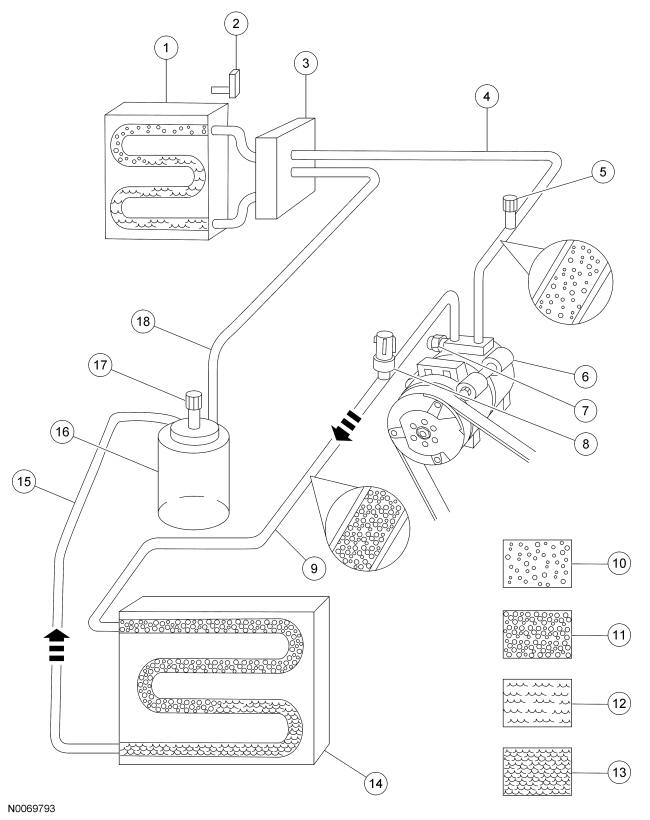
| Item | Description |
|---|---|
| 1 | A/C evaporator core |
| 2 | A/C evaporator core temperature sensor |
| 3 | TXV |
| 4 | A/C suction line |
| 5 | A/C charge valve port (low side) |
| 6 | A/C compressor |
| 7 | A/C pressure relief valve |
| 8 | A/C pressure transducer |
| 9 | Compressor discharge line |
| 10 | Low pressure vapor |
| 11 | High pressure vapor |
| 12 | Low pressure liquid |
| 13 | High pressure liquid |
| 14 | A/C condenser core |
| 15 | Condenser-to-receiver/drier line |
| 16 | A/C receiver/drier |
| 17 | A/C charge valve port (high side) |
| 18 | Evaporator inlet line |
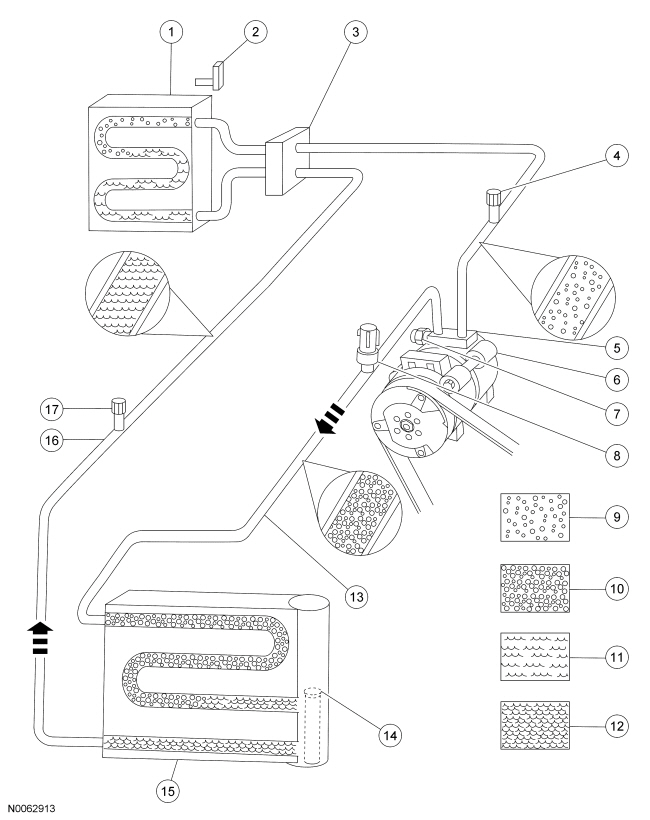
| Item | Description |
|---|---|
| 1 | A/C evaporator core |
| 2 | A/C evaporator core temperature sensor |
| 3 | TXV |
| 4 | A/C charge valve port (low side) |
| 5 | A/C suction line |
| 6 | A/C compressor |
| 7 | A/C pressure relief valve |
| 8 | A/C pressure transducer |
| 9 | Low pressure vapor |
| 10 | High pressure vapor |
| 11 | Low pressure liquid |
| 12 | High pressure liquid |
| 13 | Compressor discharge line |
| 14 | A/C desiccant bag |
| 15 | A/C condenser core with A/C receiver/drier |
| 16 | Condenser-to-evaporator line |
| 17 | A/C charge valve port (high side) |
Inspection and Verification
Visual Inspection Chart
| Mechanical | Electrical |
|---|---|
|
|
NOTE: Make sure to use the latest scan tool software release.
If the cause is not visually evident, connect the scan tool to the DLC .NOTE: The VCM LED prove-out confirms voltage and ground from the DLC are provided to the VCM .
If the scan tool does not communicate with the VCM :NOTE: Some PCM DTCs may inhibit A/C operation. If any PCM DTCs are retrieved, diagnose those first. Refer to the PCM DTC Chart.
If the PCM DTCs retrieved are related to the concern, go to the PCM DTC Chart in this section. If the HVAC module DTCs retrieved are related to the concern, go to the HVAC Module DTC Chart in this section. For all other DTCs, refer to Section 419-10 .DTC Charts
Diagnostics in this manual assume a certain skill level and knowledge of Ford-specific diagnostic practices. Refer to Diagnostic Methods in Section 100-00 for information about these practices.
PCM DTC Chart
| DTC | Description | Action to Take |
|---|---|---|
| P0532 | A/C Refrigerant Pressure Sensor A Circuit Low | GO to Pinpoint Test A . |
| P0533 | A/C Refrigerant Pressure Sensor A Circuit High | GO to Pinpoint Test A . |
| P0645 | A/C Clutch Relay Control Circuit | GO to Pinpoint Test B . |
| P06A0 | Variable A/C Compressor Control Circuit | GO to Pinpoint Test Z . |
| P1464 | A/C Demand Out Of Self Test Range | If the HVAC selector was not powered off, POWER the HVAC off, CLEAR the DTCs and REPEAT the self-test. If the DTC does not return, IGNORE the DTC and CONTINUE diagnosing other DTCs or symptoms. If the DTC returns, GO to Pinpoint Test N . |
| All Other DTCs | — | REFER to Section 303-14 . |
HVAC Module DTC Chart
NOTE: This module utilizes a 5-character DTC followed by a 2-character failure type code. The failure type code provides information about specific fault conditions such as opens or shorts to ground. CMDTCs have an additional 2-character DTC status code suffix to assist in determining DTC history.
NOTE: Network DTCs (U-codes) are often a result of intermittent concerns such as damaged wiring or low battery voltage occurrences. Additionally, vehicle repair procedures such as module reprogramming often set network DTCs. Replacing a module to resolve a network DTC is unlikely to resolve the concern. To prevent repeat network DTC concerns, inspect all network wiring, especially connectors. Test the vehicle battery, refer to Section 414-01 .
NOTE: Some PCM DTCs may inhibit A/C operation. If any PCM DTCs are retrieved, diagnose those first. Refer to the PCM DTC Chart.
| DTC | Description | Action to Take |
|---|---|---|
| B1034:11 | Left Front Seat Heater Element: Circuit Short to Ground | REFER to Section 501-10 . |
| B1034:13 | Left Front Seat Heater Element: Circuit Open | REFER to Section 501-10 . |
| B1036:11 | Right Front Seat Heater Element: Circuit Short to Ground | REFER to Section 501-10 . |
| B1036:13 | Right Front Seat Heater Element: Circuit Open | REFER to Section 501-10 . |
| B1038:11 | Left Front Seat Heater Sensor: Circuit Short to Ground | REFER to Section 501-10 . |
| B1038:12 | Left Front Seat Heater Sensor: Circuit Short to Battery | REFER to Section 501-10 . |
| B103A:11 | Right Front Seat Heater Sensor: Circuit Short to Ground | REFER to Section 501-10 . |
| B103A:12 | Right Front Seat Heater Sensor: Circuit Short to Battery | REFER to Section 501-10 . |
| B1081:07 | Left Temperature Damper Motor: Mechanical Failure | INSPECT for binding/damaged linkage or door. REPAIR as necessary. If no condition is found, INSTALL a new LH temperature blend door actuator. REFER to Section 412-01 . CLEAR the DTCs. REPEAT the self-test. TEST the system for normal operation. |
| B1081:11 | Left Temperature Damper Motor: Circuit Short to Ground | GO to Pinpoint Test O . |
| B1081:12 | Left Temperature Damper Motor: Circuit Short to Battery | GO to Pinpoint Test O . |
| B1081:13 | Left Temperature Damper Motor: Circuit Open | GO to Pinpoint Test O . |
| B1082:07 | Right Temperature Damper Motor: Mechanical Failure | INSPECT for binding/damaged linkage or door. REPAIR as necessary. If no condition is found, INSTALL a new RH temperature blend door actuator. REFER to Section 412-01 . CLEAR the DTCs. REPEAT the self-test. TEST the system for normal operation. |
| B1082:11 | Right Temperature Damper Motor: Circuit Short to Ground | GO to Pinpoint Test P . |
| B1082:12 | Right Temperature Damper Motor: Circuit Short to Battery | GO to Pinpoint Test P . |
| B1082:13 | Right Temperature Damper Motor: Circuit Open | GO to Pinpoint Test P . |
| B1083:07 | Recirculation Damper Motor: Mechanical Failure | INSPECT for binding/damaged linkage or door. REPAIR as necessary. If no condition is found, INSTALL a new air inlet mode door actuator. REFER to Section 412-01 . CLEAR the DTCs. REPEAT the self-test. TEST the system for normal operation. |
| B1083:11 | Recirculation Damper Motor: Circuit Short to Ground | GO to Pinpoint Test I . |
| B1083:12 | Recirculation Damper Motor: Circuit Short to Battery | GO to Pinpoint Test I . |
| B1083:13 | Recirculation Damper Motor: Circuit Open | GO to Pinpoint Test I . |
| B1086:07 | Air Distribution Damper Motor: Mechanical Failure | INSPECT for binding/damaged linkage or door. REPAIR as necessary. If no condition is found, INSTALL a new defrost/panel/floor mode door actuator. REFER to Section 412-01 . CLEAR the DTCs. REPEAT the self-test. TEST the system for normal operation. |
| B1086:11 | Air Distribution Damper Motor: Circuit Short to Ground | GO to Pinpoint Test J . |
| B1086:12 | Air Distribution Damper Motor: Circuit Short to Battery | GO to Pinpoint Test J . |
| B1086:13 | Air Distribution Damper Motor: Circuit Open | GO to Pinpoint Test J . |
| B10AF:12 | Blower Fan Relay: Circuit Short to Battery | GO to Pinpoint Test Q . |
| B10AF:13 | Blower Fan Relay: Circuit Open | GO to Pinpoint Test Q . |
| B10B0:12 | Rear Blower Fan Relay: Circuit Short to Battery | GO to Pinpoint Test S . |
| B10B0:13 | Rear Blower Fan Relay: Circuit Open | GO to Pinpoint Test S . |
| B10B7:11 | Rear Air Discharge Temperature: Circuit Short to Ground | GO to Pinpoint Test U . |
| B10B7:15 | Rear Air Discharge Temperature: Circuit Short to Battery or Open | GO to Pinpoint Test U . |
| B10B9:12 | Blower Control: Circuit Short to Battery | GO to Pinpoint Test R . |
| B10B9:14 | Blower Control: Circuit Short to Ground or Open | GO to Pinpoint Test Q . |
| B10BA:12 | Rear Blower Control: Circuit Short to Battery | GO to Pinpoint Test T . |
| B10BA:14 | Rear Blower Control: Circuit Short to Ground or Open | If the auxiliary blower motor does not operate, REFER to
GO to Pinpoint Test S
.
If the auxiliary blower motor is always on HIGH, REFER to GO to Pinpoint Test T . |
| B11E3:07 | Rear HVAC Damper Motor: Mechanical Failure | INSPECT for binding/damaged linkage or door. REPAIR as necessary. If no condition is found, INSTALL a new Auxiliary temperature blend door actuator. REFER to Section 412-02 . CLEAR the DTCs. REPEAT the self-test. TEST the system for normal operation. |
| B11E3:11 | Rear HVAC Damper Motor: Circuit Short to Ground | GO to Pinpoint Test U . |
| B11E3:12 | Rear HVAC Damper Motor: Circuit Short to Battery | GO to Pinpoint Test U . |
| B11E3:13 | Rear HVAC Damper Motor: Circuit Open | GO to Pinpoint Test U . |
| B11E4:07 | Rear Air Distribution Damper Motor: Mechanical Failure | INSPECT for binding/damaged linkage or door. REPAIR as necessary. If no condition is found, INSTALL a new auxiliary mode door actuator. REFER to Section 412-02 . CLEAR the DTCs. REPEAT the self-test. TEST the system for normal operation. |
| B11E4:11 | Rear Air Distribution Damper Motor: Circuit Short to Ground | GO to Pinpoint Test V . |
| B11E4:12 | Rear Air Distribution Damper Motor: Circuit Short to Battery | GO to Pinpoint Test V . |
| B11E4:13 | Rear Air Distribution Damper Motor: Circuit Open | GO to Pinpoint Test V . |
| B11E5:11 | Left HVAC Damper Position Sensor: Circuit Short to Ground | GO to Pinpoint Test O . |
| B11E5:15 | Left HVAC Damper Position Sensor: Circuit Short to Battery or Open | GO to Pinpoint Test O . |
| B11E6:11 | Right HVAC Damper Position Sensor: Circuit Short to Ground | GO to Pinpoint Test P . |
| B11E6:15 | Right HVAC Damper Position Sensor: Circuit Short to Battery or Open | GO to Pinpoint Test P . |
| B11E7:11 | Air Distribution Damper Position Sensor: Circuit Short to Ground | GO to Pinpoint Test J . |
| B11E7:15 | Air Distribution Damper Position Sensor: Circuit Short to Battery or Open | GO to Pinpoint Test J . |
| B11EB:11 | Rear HVAC Temperature Control Input: Circuit Short To Ground | GO to Pinpoint Test W . |
| B11EB:15 | Rear HVAC Temperature Control Input: Circuit Short To Battery or Open | GO to Pinpoint Test W . |
| B11EC:11 | Rear HVAC Blower Control Input: Circuit Short To Ground | GO to Pinpoint Test W . |
| B11EC:15 | Rear HVAC Blower Control Input: Circuit Short To Battery or Open | GO to Pinpoint Test W . |
| B11F0:11 | Air Intake Damper Position Sensor: Circuit Short To Ground | GO to Pinpoint Test I . |
| B11F0:15 | Air Intake Damper Position Sensor: Circuit Short To Battery or Open | GO to Pinpoint Test I . |
| B121D:11 | Rear HVAC Mode Control Input: Circuit Short To Ground | GO to Pinpoint Test W . |
| B121D:15 | Rear HVAC Mode Control Input: Circuit Short To Battery or Open | GO to Pinpoint Test W . |
| B127C:11 | Ambient Lighting Zone 2 Output Red LED: Circuit Short To Ground | REFER to Section 417-02 . |
| B127C:12 | Ambient Lighting Zone 2 Output Red LED: Circuit Short To Battery | REFER to Section 417-02 . |
| B127C:13 | Ambient Lighting Zone 2 Output Red LED: Circuit Open | REFER to Section 417-02 . |
| B127F:11 | Ambient Lighting Zone 2 Output Green LED: Circuit Short To Ground | REFER to Section 417-02 . |
| B127F:12 | Ambient Lighting Zone 2 Output Green LED: Circuit Short To Battery | REFER to Section 417-02 . |
| B127F:13 | Ambient Lighting Zone 2 Output Green LED: Circuit Open | REFER to Section 417-02 . |
| B1282:11 | Ambient Lighting Zone 2 Output Blue LED: Circuit Short To Ground | REFER to Section 417-02 . |
| B1282:12 | Ambient Lighting Zone 2 Output Blue LED: Circuit Short To Battery | REFER to Section 417-02 . |
| B1282:13 | Ambient Lighting Zone 2 Output Blue LED: Circuit Open | REFER to Section 417-02 . |
| B12F2:11 | Ambient Lighting Zone 2 Output: Circuit Short To Ground | REFER to Section 417-02 . |
| B12F2:12 | Ambient Lighting Zone 2 Output: Circuit Short To Battery | REFER to Section 417-02 . |
| B12F2:13 | Ambient Lighting Zone 2 Output: Circuit Open | REFER to Section 417-02 . |
| B1A61:11 | Cabin Temperature Sensor Circuit Open: Circuit Short to Ground | GO to Pinpoint Test D . |
| B1A61:15 | Cabin Temperature Sensor Circuit Open: Circuit Short to Battery or Open | If
only
DTC B1A61:15 is set,
GO to Pinpoint Test D
.
If DTCs B1A61:15, B1A63:15 and B1A64:15 all set, GO to Pinpoint Test AB . |
| B1A63:11 | Right Solar Sensor: Circuit Short to Ground | GO to Pinpoint Test E . |
| B1A63:15 | Right Solar Sensor: Circuit Short to Battery or Open | If
only
DTC B1A63:15 is set,
GO to Pinpoint Test E
.
If DTCs B1A61:15, B1A63:15 and B1A64:15 all set, GO to Pinpoint Test AB . |
| B1A64:11 | Left Solar Sensor: Circuit Short to Ground | GO to Pinpoint Test E . |
| B1A64:15 | Left Solar Sensor: Circuit Short to Battery or Open | If
only
DTC B1A64:15 is set,
GO to Pinpoint Test E
.
If DTCs B1A61:15, B1A63:15 and B1A64:15 all set, GO to Pinpoint Test AB . |
| B1A69:11 | Humidity Sensor: Circuit Short to Ground | GO to Pinpoint Test Y . |
| B1A69:15 | Humidity Sensor: Circuit Short to Battery or Open | GO to Pinpoint Test Y . |
| B1B71:11 | Evaporator Temperature Sensor: Circuit Short to Ground | GO to Pinpoint Test F . |
| B1B71:15 | Evaporator Temperature Sensor: Circuit Short to Battery or Open | GO to Pinpoint Test F . |
| B1B7D:11 | Rear Air Distribution Actuator: Circuit Short to Ground | GO to Pinpoint Test V . |
| B1B7D:15 | Rear Air Distribution Actuator: Circuit Short to Battery or Open | GO to Pinpoint Test V . |
| B1C83:11 | Rear Defog Relay: Circuit Short to Ground | REFER to Section 501-11 . |
| B1C83:13 | Rear Defog Relay: Circuit Open | REFER to Section 501-11 . |
| C1B14:11 | Sensor Supply Voltage A: Circuit Short to Ground | GO to Pinpoint Test C . |
| C1B14:12 | Sensor Supply Voltage A: Circuit Short to Battery | GO to Pinpoint Test C . |
| U0140:00 | Lost Communication With Body Control Module: No Sub Type Information | GO to Pinpoint Test AA . |
| U0401:09 | Invalid Data Received From ECM/PCM A: Component Failure | RETRIEVE and REPAIR all non-network DTCs in the PCM. REFER to Section 303-14 DTC Chart. |
| U0401:68 | Invalid Data Received From ECM/PCM A: Event Information | RETRIEVE and REPAIR all non-network DTCs in the PCM. REFER to Section 303-14 DTC Chart. |
| U0401:81 | Invalid Data Received From ECM/PCM A: Invalid Serial Data Received | RETRIEVE and REPAIR all non-network DTCs in the PCM. REFER to Section 303-14 DTC Chart. |
| U0401:82 | Invalid Data Received From ECM/PCM A: Alive/Sequence Counter Incorrect/Not Updated | RETRIEVE and REPAIR all non-network DTCs in the PCM. REFER to Section 303-14 DTC Chart. |
| U0422:68 | Invalid Data Received From Body Control Module: Event Information | RETRIEVE and REPAIR all non-network DTCs in the BCM . REFER to Section 419-10 DTC Chart. |
| U0422:81 | Invalid Data Received From Body Control Module: Invalid Serial Data Received | RETRIEVE and REPAIR all non-network DTCs in the BCM . REFER to Section 419-10 DTC Chart. |
| U0423:82 | Invalid Data Received From Instrument Panel Cluster Control Module: Alive/Sequence Counter Incorrect/Not Updated | RETRIEVE and REPAIR all non-network DTCs in the IPC . REFER to Section 413-01 DTC Chart. |
| U0554:82 | Invalid Data Received From Accessory Protocol Interface Module: Alive/Sequence Counter Incorrect/Not Updated | This DTC can set due to a fault in the APIM . RETRIEVE and REPAIR all non-network DTCs in the APIM . REFER to Section 415-00A , Section 415-00B or Section 415-00C . |
| U1000:00 | Solid State Driver Protection Activated — Driver Disabled: No Sub Type Information | The HVAC module has temporarily disabled an output because an excessive current draw exists (such as a short to ground). The HVAC module cannot enable the output until the cause of the short is corrected. ADDRESS all other DTCs first. After the cause of the concern is corrected, CLEAR the DTCs. REPEAT the self-test. |
| U2024:51 | Control Module Cal-Config Data: Not Programmed | CARRY OUT PMI on the HVAC module. REFER to Section 418-01 . REPEAT the self-test. If PMI is successful, the DTC will not be present. If the DTC returns, INSTALL a new HVAC module. REFER to Section 412-01 . |
| U2100:00 | Initial Configuration Not Complete: No Sub Type Information | CARRY OUT PMI on the HVAC module. REFER to Section 418-01 . REPEAT the self-test. If PMI is successful, the DTC will not be present. If the DTC returns, INSTALL a new HVAC module. REFER to Section 412-01 . |
| U3000:49 | Control Module: Internal Electronic Failure | The module has permanently disabled an output because an excessive current draw fault (such as a short to ground) has exceeded the limits that the HVAC module can withstand. The cause of the excessive current draw MUST be corrected before a new HVAC module is installed. ADDRESS all other DTCs first. CLEAR the DTCs. REPEAT the self-test. If DTC U3000:49 is retrieved again, INSTALL a new HVAC module. REFER to Section 412-01 . |
| U3002:62 | Vehicle Identification Number: Signal Compare Failure | CARRY OUT PMI on the HVAC module using the scan tool. REFER to Section 418-01 .REPEAT the self-test. If PMI is successful, the DTC will not be present. If the DTC returns, INSTALL a new HVAC module. REFER to Section 412-01 . |
| U3003:16 | Battery Voltage: Circuit Voltage Below Threshold | GO to Pinpoint Test G . |
| U3003:17 | Battery Voltage: Circuit Voltage Above Threshold | GO to Pinpoint Test G . |
| All Other DTCs | — | REFER to the Master DTC Chart in Section 419-10 . |
Symptom Chart — Climate Control Systems
| Condition | Possible Sources | Action |
|---|---|---|
|
|
|
|
| |
|
|
|
|
|
|
|
| |
|
| |
|
|
|
|
| |
|
| |
|
|
|
|
| |
|
| |
|
| |
|
| |
|
| |
|
| |
|
|
|
|
|
|
|
|
|
|
| |
|
|
|
Symptom Chart — NVH
| Condition | Possible Sources | Action |
|---|---|---|
|
|
|
|
| |
|
|
|
Pinpoint Tests
Pinpoint Test A: DTC P0532 or P0533
Diagnostics in this manual assume a certain skill level and knowledge of Ford-specific diagnostic practices. Refer to Diagnostic Methods in Section 100-00 for information about these practices.
Refer to Wiring Diagrams Cell 54 , Manual Climate Control System for schematic and connector information.
Refer to Wiring Diagrams Cell 55 , Automatic Climate Control System for schematic and connector information.
The A/C pressure transducer receives a ground from the PCM. A 5-volt reference voltage is supplied to the A/C pressure transducer from the PCM. The A/C pressure transducer then sends a voltage to the PCM to indicate the A/C refrigerant pressure.
DTC Fault Trigger Conditions
| DTC | Description | Fault Trigger Conditions |
|---|---|---|
| P0532 | A/C Refrigerant Pressure Sensor A Circuit Low: No Sub Type Information | The A/C pressure transducer inputs a feedback voltage to the PCM. This DTC sets if the feedback voltage is less than 0.26 volts for at least 2 seconds and the ambient air temperature is greater than 0°C (32°F). |
| P0533 | A/C Refrigerant Pressure Sensor A Circuit High: No Sub Type Information | The A/C pressure transducer inputs a feedback voltage to the PCM. This DTC sets if the feedback voltage is greater than 4.95 volts for at least 2 seconds and the ambient air temperature is greater than 0°C (32°F). |
| Test Step | Result / Action to Take | ||||||||||||||||||||||||
|---|---|---|---|---|---|---|---|---|---|---|---|---|---|---|---|---|---|---|---|---|---|---|---|---|---|
| A1 CHECK THE PCM OUTPUT VOLTAGE | |||||||||||||||||||||||||
 | Yes
GO to A4 . No If the voltage is below 4.7 volts, GO to A2 . If the voltage is greater than 5.1 volts, REPAIR the circuit. | ||||||||||||||||||||||||
| A2 CHECK THE REFERENCE VOLTAGE CIRCUIT FOR A SHORT TO GROUND | |||||||||||||||||||||||||
 | Yes
GO to A3 . No REPAIR the circuit. | ||||||||||||||||||||||||
| A3 CHECK THE REFERENCE VOLTAGE CIRCUIT FOR AN OPEN | |||||||||||||||||||||||||
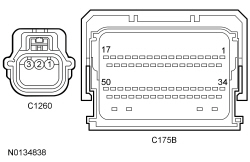
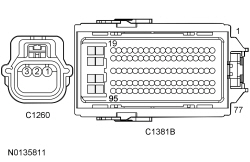 | Yes
GO to A13 . No REPAIR the circuit. | ||||||||||||||||||||||||
| A4 CHECK THE PCM SENSOR GROUND | |||||||||||||||||||||||||
 | Yes
If diagnosing DTC P0532 , GO to A7 . If diagnosing DTC P0533 , GO to A10 . No GO to A5 . | ||||||||||||||||||||||||
| A5 CHECK THE SIGNAL RETURN CIRCUIT FOR VOLTAGE | |||||||||||||||||||||||||
 | Yes
If the voltage is 5.1 volts or less, REPAIR circuit. RE407 (YE/VT) for a short to circuit LE424 (YE/GN). If the voltage is greater than 5.1 volts REPAIR circuit RE407 (YE/VT) for a short to voltage. No GO to A6 . | ||||||||||||||||||||||||
| A6 CHECK THE SIGNAL RETURN CIRCUIT FOR AN OPEN | |||||||||||||||||||||||||

 | Yes
GO to A13 . No REPAIR the circuit. | ||||||||||||||||||||||||
| A7 CHECK THE A/C PRESSURE SENSOR (ACP_V) PCM PID WITH THE A/C PRESSURE TRANSDUCER SHORTED | |||||||||||||||||||||||||
 | Yes
INSTALL a new A/C pressure transducer. No GO to A8 . | ||||||||||||||||||||||||
| A8 CHECK THE A/C PRESSURE TRANSDUCER FEEDBACK CIRCUIT FOR A SHORT TO THE SIGNAL RETURN CIRCUIT | |||||||||||||||||||||||||
 | Yes
GO to A9 . No REPAIR circuit VH433 (VT/OG) for a short to circuit RE407 (YE/VT). | ||||||||||||||||||||||||
| A9 CHECK THE A/C PRESSURE TRANSDUCER FEEDBACK CIRCUIT FOR AN OPEN | |||||||||||||||||||||||||

 | Yes
GO to A13 . No REPAIR the circuit. | ||||||||||||||||||||||||
| A10 CHECK THE A/C PRESSURE TRANSDUCER | |||||||||||||||||||||||||
| Yes
INSTALL a new A/C pressure transducer. No GO to A11 . | ||||||||||||||||||||||||
| A11 CHECK THE A/C PRESSURE TRANSDUCER FEEDBACK CIRCUIT FOR VOLTAGE | |||||||||||||||||||||||||
 | Yes
GO to A12 . No GO to A13 . | ||||||||||||||||||||||||
| A12 CHECK THE A/C PRESSURE TRANSDUCER FEEDBACK CIRCUIT FOR A SHORT TO VOLTAGE | |||||||||||||||||||||||||
 | Yes
REPAIR the circuit. No REPAIR circuit VH433 (VT/OG) for a short to circuit LE424 (YE/GN). | ||||||||||||||||||||||||
| A13 CHECK FOR CORRECT PCM OPERATION | |||||||||||||||||||||||||
| Yes
CHECK OASIS for any applicable TSBs . If a TSB exists for this concern, DISCONTINUE this test and FOLLOW TSB instructions. If no TSB addresses this concern, INSTALL a new PCM. REFER to Section 303-14 . No The system is operating correctly at this time. The concern may have been caused by module connections. ADDRESS the root cause of any connector or pin issues. |
Pinpoint Test B: DTC P0645
Diagnostics in this manual assume a certain skill level and knowledge of Ford-specific diagnostic practices. Refer to Diagnostic Methods in Section 100-00 for information about these practices.
Refer to Wiring Diagrams Cell 54 , Manual Climate Control System for schematic and connector information.
Refer to Wiring Diagrams Cell 55 , Automatic Climate Control System for schematic and connector information.
Voltage is provided to the A/C clutch relay coil. When A/C is requested and A/C line pressures allow, a ground is provided to the A/C clutch relay coil from the PCM, energizing the A/C clutch relay.
DTC Fault Trigger Conditions
| DTC | Description | Fault Trigger Conditions |
|---|---|---|
| P0645 | A/C Clutch Relay Control Circuit: No Sub Type Information | The DTC sets when the PCM grounds the relay circuit and more current than expected is detected on the relay circuit. The DTC also sets when the relay circuit is off and no voltage is detected on the relay circuit. |
| Test Step | Result / Action to Take | ||||||||||||||||||||||||
|---|---|---|---|---|---|---|---|---|---|---|---|---|---|---|---|---|---|---|---|---|---|---|---|---|---|
| B1 CHECK THE VOLTAGE TO THE A/C CLUTCH RELAY | |||||||||||||||||||||||||
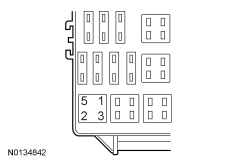 | Yes
GO to B2 . No VERIFY BJB fuse 70 (15A) is OK. If OK, REPAIR the circuit. If not OK, REFER to the Wiring Diagrams manual to identify the possible causes of the circuit short. | ||||||||||||||||||||||||
| B2 CHECK THE A/C CLUTCH RELAY | |||||||||||||||||||||||||
| Yes
GO to B3 . No INSTALL a new A/C clutch relay. | ||||||||||||||||||||||||
| B3 CHECK THE A/C CLUTCH RELAY COIL CONTROL CIRCUIT FOR A SHORT TO VOLTAGE | |||||||||||||||||||||||||
 | Yes
REPAIR the circuit. No GO to B4 . | ||||||||||||||||||||||||
| B4 CHECK THE A/C CLUTCH RELAY COIL CONTROL CIRCUIT FOR A SHORT TO GROUND | |||||||||||||||||||||||||
 | Yes
GO to B5 . No REPAIR the circuit. | ||||||||||||||||||||||||
| B5 CHECK THE A/C CLUTCH RELAY COIL CONTROL CIRCUIT FOR AN OPEN | |||||||||||||||||||||||||
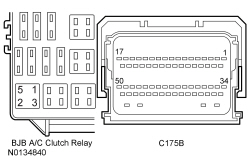
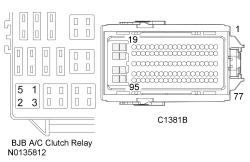 | Yes
GO to B6 . No REPAIR the circuit. | ||||||||||||||||||||||||
| B6 CHECK FOR CORRECT PCM OPERATION | |||||||||||||||||||||||||
| Yes
CHECK OASIS for any applicable TSBs . If a TSB exists for this concern, DISCONTINUE this test and FOLLOW TSB instructions. If no TSB addresses this concern, INSTALL a new PCM. REFER to Section 303-14 . No The system is operating correctly at this time. The concern may have been caused by module connections. ADDRESS the root cause of any connector or pin issues. |
Pinpoint Test C: DTCs C1B14:11 or 12
Diagnostics in this manual assume a certain skill level and knowledge of Ford-specific diagnostic practices. Refer to Diagnostic Methods in Section 100-00 for information about these practices.
Refer to Wiring Diagrams Cell 54 , Manual Climate Control System for schematic and connector information.
Refer to Wiring Diagrams Cell 55 , Automatic Climate Control System for schematic and connector information.
A 5-volt reference voltage is supplied to the sensors and actuators from the HVAC module.
DTC Fault Trigger Conditions
| DTC | Description | Fault Trigger Conditions |
|---|---|---|
| C1B14:11 | Sensor Supply Voltage A: Circuit Short to Ground | This CMDTC sets when the HVAC module senses less than 5 volts on the sensor reference voltage circuit, indicating a short to ground. |
| C1B14:12 | Sensor Supply Voltage A: Circuit Short to Battery | This CMDTC sets when the HVAC module senses greater than 5 volts on the sensor reference voltage circuit, indicating a short to voltage. |
| Test Step | Result / Action to Take | ||||||||||||||||||||||||
|---|---|---|---|---|---|---|---|---|---|---|---|---|---|---|---|---|---|---|---|---|---|---|---|---|---|
| C1 CHECK THE HVAC MODULE DTCs | |||||||||||||||||||||||||
| Yes
GO to C2 . No GO to C5 . | ||||||||||||||||||||||||
| C2 CHECK THE REFERENCE VOLTAGE CIRCUIT FOR A SHORT TO GROUND | |||||||||||||||||||||||||
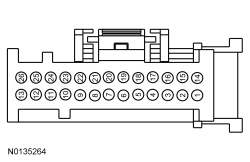
 | Yes
GO to C3 . No REPAIR the circuit. | ||||||||||||||||||||||||
| C3 CHECK THE REFERENCE VOLTAGE CIRCUIT AND THE SIGNAL RETURN CIRCUIT FOR A SHORT TOGETHER | |||||||||||||||||||||||||

 | Yes
GO to C6 . No GO to C4 . | ||||||||||||||||||||||||
| C4 CHECK THE A/C COMPONENTS | |||||||||||||||||||||||||

 | Yes
INSTALL a new actuator (the last one to be disconnected). REFER to Section 412-01 . When installing an actuator, CONNECT the actuator electrical connector before the HVAC module connector(s). This allows the actuator to be calibrated when the HVAC module is reconnected. TEST the system for normal operation. No REPAIR circuits LH111 (BN/WH) and RH111 (GY/BU) for a short together. | ||||||||||||||||||||||||
| C5 CHECK THE REFERENCE VOLTAGE CIRCUIT FOR A SHORT TO VOLTAGE | |||||||||||||||||||||||||

 | Yes
REPAIR the circuit. No GO to C6 . | ||||||||||||||||||||||||
| C6 CHECK FOR CORRECT HVAC MODULE OPERATION | |||||||||||||||||||||||||
| Yes
CHECK OASIS for any applicable TSBs . If a TSB exists for this concern, DISCONTINUE this test and FOLLOW TSB instructions. If no TSB addresses this concern, INSTALL a new HVAC module. REFER to Section 412-01 . No The system is operating correctly at this time. The concern may have been caused by module connections. ADDRESS the root cause of any connector or pin issues. |
Pinpoint Test D: DTCs B1A61:11 or 15
Diagnostics in this manual assume a certain skill level and knowledge of Ford-specific diagnostic practices. Refer to Diagnostic Methods in Section 100-00 for information about these practices.
Refer to Wiring Diagrams Cell 54 , Manual Climate Control System for schematic and connector information.
Refer to Wiring Diagrams Cell 55 , Automatic Climate Control System for schematic and connector information.
The in-vehicle temperature and humidity sensor receives a ground from the HVAC module. The sensor varies its resistance with the temperature. As the temperature rises, the resistance falls. As the temperature falls the resistance rises. The HVAC module measures this resistance to determine the temperature at the sensor. The sensor DTCs set if there is a fault in either the temperature or humidity part of the sensor or circuits.
DTC Fault Trigger Conditions
| DTC | Description | Fault Trigger Conditions |
|---|---|---|
| B1A61:11 | Cabin Temperature Sensor: Circuit Short to Ground | This CMDTC and on demand DTC sets when the HVAC module senses lower than expected voltage on the sensor feedback circuit, indicating a short to ground. |
| B1A61:15 | Cabin Temperature Sensor: Circuit Short to Battery or Open | This CMDTC and on demand DTC sets when the HVAC module senses greater than expected voltage on the sensor feedback circuit, indicating a short to voltage or an open circuit or sensor. |
| Test Step | Result / Action to Take | ||||||||||||||||||||||||
|---|---|---|---|---|---|---|---|---|---|---|---|---|---|---|---|---|---|---|---|---|---|---|---|---|---|
| D1 CHECK THE IN-VEHICLE TEMPERATURE/HUMIDITY SENSOR RESISTANCE | |||||||||||||||||||||||||
| Yes
GO to D2 . No INSTALL a new in-vehicle temperature/humidity sensor. REFER to Section 412-01 . | ||||||||||||||||||||||||
| D2 CHECK THE HVAC MODULE OUTPUT VOLTAGE | |||||||||||||||||||||||||
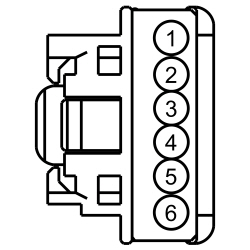 | Yes
INSTALL a new in-vehicle temperature/humidity sensor. REFER to Section 412-01 . CLEAR the DTCs. REPEAT the self-test. If the DTC returns, GO to D8 . No For DTC B1A61:11 , GO to D6 . For DTC B1A61:15 , GO to D3 . | ||||||||||||||||||||||||
| D3 CHECK THE IN-VEHICLE TEMPERATURE/HUMIDITY SENSOR FEEDBACK CIRCUIT FOR AN OPEN | |||||||||||||||||||||||||
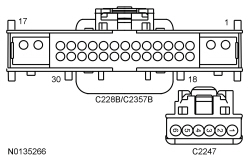
 | Yes
GO to D4 . No REPAIR the circuit. | ||||||||||||||||||||||||
| D4 CHECK THE SIGNAL RETURN CIRCUIT FOR AN OPEN | |||||||||||||||||||||||||
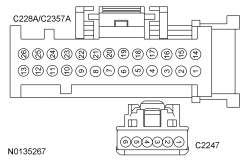
 | Yes
GO to D5 . No REPAIR the circuit. | ||||||||||||||||||||||||
| D5 CHECK THE SIGNAL RETURN CIRCUIT FOR SHORT TO VOLTAGE | |||||||||||||||||||||||||
 | Yes
REPAIR the circuit. No GO to D8 . | ||||||||||||||||||||||||
| D6 CHECK THE IN-VEHICLE TEMPERATURE/HUMIDITY SENSOR FEEDBACK CIRCUIT FOR A SHORT TO THE SIGNAL RETURN CIRCUIT | |||||||||||||||||||||||||
 | Yes
GO to D7 . No REPAIR the circuits. | ||||||||||||||||||||||||
| D7 CHECK THE IN-VEHICLE TEMPERATURE SENSOR FEEDBACK CIRCUIT FOR A SHORT TO GROUND | |||||||||||||||||||||||||
 | Yes
GO to D8 . No REPAIR the circuit. | ||||||||||||||||||||||||
| D8 CHECK FOR CORRECT HVAC MODULE OPERATION | |||||||||||||||||||||||||
| Yes
CHECK OASIS for any applicable TSBs . If a TSB exists for this concern, DISCONTINUE this test and FOLLOW TSB instructions. If no TSB addresses this concern, INSTALL a new HVAC module. REFER to Section 412-01 . No The system is operating correctly at this time. The concern may have been caused by module connections. ADDRESS the root cause of any connector or pin issues. |
Pinpoint Test E: DTCs B1A63:11, B1A63:15, B1A64:11, B1A64:15
Diagnostics in this manual assume a certain skill level and knowledge of Ford-specific diagnostic practices. Refer to Diagnostic Methods in Section 100-00 for information about these practices.
Refer to Wiring Diagrams Cell 54 , Manual Climate Control System for schematic and connector information.
Refer to Wiring Diagrams Cell 55 , Automatic Climate Control System for schematic and connector information.
As the light applied to the sensor changes, the HVAC module detects the change through the RH and LH feedback circuits.
DTC Fault Trigger Conditions
| DTC | Description | Fault Trigger Conditions |
|---|---|---|
| B1A63:11 | Right Solar Sensor: Circuit Short to Ground | This CMDTC and on demand DTC sets when the HVAC module senses lower than expected voltage on the RH sensor feedback circuit, indicating a short to ground. |
| B1A63:15 | Right Solar Sensor: Circuit Short to Battery or Open | This CMDTC and on demand DTC sets when the HVAC module senses greater than expected voltage on the RH sensor feedback circuit, indicating a short to voltage or an open circuit or sensor. |
| B1A64:11 | Left Solar Sensor: Circuit Short to Ground | This CMDTC and on demand DTC sets when the HVAC module senses lower than expected voltage on the LH sensor feedback circuit, indicating a short to ground. |
| B1A64:15 | Left Solar Sensor: Circuit Short to Battery or Open | This CMDTC and on demand DTC sets when the HVAC module senses greater than expected voltage on the LH sensor feedback circuit, indicating a short to voltage or an open circuit or sensor. |
| Test Step | Result / Action to Take | ||||||||||||||||||||||||
|---|---|---|---|---|---|---|---|---|---|---|---|---|---|---|---|---|---|---|---|---|---|---|---|---|---|
| E1 CHECK THE AUTOLAMP/SUNLOAD SENSOR REFERENCE VOLTAGE | |||||||||||||||||||||||||
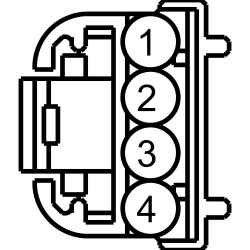
 | Yes
INSTALL a new autolamp/sunload sensor. No If DTCs B1A63:15 and B1A64:15 are both set, GO to E2 . If diagnosing DTC B1A63:11 or DTC B1A64:11 , GO to E5 . If diagnosing DTC B1A63:15 or DTC B1A64:15 , GO to E3 . | ||||||||||||||||||||||||
| E2 CHECK THE AUTOLAMP/SUNLOAD SENSOR GROUND CIRCUIT FOR AN OPEN | |||||||||||||||||||||||||
 | Yes
INSTALL a new autolamp/sunload sensor. No REPAIR the circuit. | ||||||||||||||||||||||||
| E3 CHECK THE AUTOLAMP/SUNLOAD SENSOR FEEDBACK CIRCUITS FOR AN OPEN | |||||||||||||||||||||||||
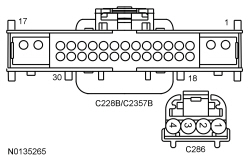
 | Yes
GO to E4 . No REPAIR the circuit. | ||||||||||||||||||||||||
| E4 CHECK THE AUTOLAMP/SUNLOAD SENSOR FEEDBACK CIRCUITS FOR A SHORT TO VOLTAGE | |||||||||||||||||||||||||

 | Yes
REPAIR the circuit. No GO to E6 . | ||||||||||||||||||||||||
| E5 CHECK THE AUTOLAMP/SUNLOAD SENSOR FEEDBACK CIRCUITS FOR A SHORT TO GROUND | |||||||||||||||||||||||||

 | Yes
GO to E6 . No REPAIR the circuit. | ||||||||||||||||||||||||
| E6 CHECK FOR CORRECT HVAC MODULE OPERATION | |||||||||||||||||||||||||
| Yes
CHECK OASIS for any applicable TSBs . If a TSB exists for this concern, DISCONTINUE this test and FOLLOW TSB instructions. If no TSB addresses this concern, INSTALL a new HVAC module. REFER to Section 412-01 . No The system is operating correctly at this time. The concern may have been caused by module connections. ADDRESS the root cause of any connector or pin issues. |
Pinpoint Test F: DTCs B1B71:11 or 15
Diagnostics in this manual assume a certain skill level and knowledge of Ford-specific diagnostic practices. Refer to Diagnostic Methods in Section 100-00 for information about these practices.
Refer to Wiring Diagrams Cell 54 , Manual Climate Control System for schematic and connector information.
Refer to Wiring Diagrams Cell 55 , Automatic Climate Control System for schematic and connector information.
The evaporator temperature sensor receives a ground from the HVAC module. The sensor varies its resistance with the temperature. As the temperature rises, the resistance falls. As the temperature falls, the resistance rises. The HVAC module measures this resistance to determine the temperature at the sensor.
The evaporator temperature sensor is used for A/C compressor cycling. An accurate evaporator temperature is critical to prevent evaporator icing. The HVAC module uses the temperature measurement to turn off the A/C compressor before the evaporator temperatures are cold enough to freeze the condensation. This prevents ice blockage of airflow over the evaporator core.
DTC Fault Trigger Conditions
| DTC | Description | Fault Trigger Conditions |
|---|---|---|
| B1B71:11 | Evaporator Temperature Sensor: Circuit Short to Ground | This CMDTC and on demand DTC sets when the HVAC module senses lower than expected voltage on the sensor feedback circuit, indicating a short to ground. |
| B1B71:15 | Evaporator Temperature Sensor: Circuit Short to Battery or Open | This CMDTC and on demand DTC sets when the HVAC module senses greater than expected voltage on the sensor feedback circuit, indicating a short to voltage or an open circuit or sensor. |
| Test Step | Result / Action to Take | ||||||||||||||||||||||||
|---|---|---|---|---|---|---|---|---|---|---|---|---|---|---|---|---|---|---|---|---|---|---|---|---|---|
| F1 CHECK THE EVAPORATOR TEMPERATURE SENSOR RESISTANCE | |||||||||||||||||||||||||
| Yes
GO to F2 . No INSTALL a new evaporator temperature sensor (part of 19850). REFER to Section 412-01 , Heater Core And Evaporator Core Housing procedure. | ||||||||||||||||||||||||
| F2 CHECK THE HVAC MODULE OUTPUT VOLTAGE | |||||||||||||||||||||||||
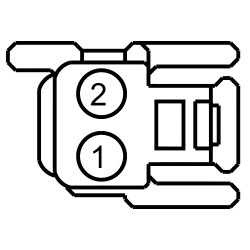 | Yes
INSTALL a new evaporator temperature sensor (part of 19850). REFER to Section 412-01 , Heater Core And Evaporator Core Housing procedure. CLEAR the DTCs. REPEAT the self-test. TEST the system for normal operation. If the DTC returns, GO to F8 . No For DTC B1B71:11 , GO to F6 . For DTC B1B71:15 , GO to F3 . | ||||||||||||||||||||||||
| F3 CHECK THE EVAPORATOR TEMPERATURE SENSOR FEEDBACK CIRCUIT FOR A SHORT TO VOLTAGE | |||||||||||||||||||||||||

 | Yes
REPAIR the circuit. No GO to F4 . | ||||||||||||||||||||||||
| F4 CHECK THE EVAPORATOR TEMPERATURE SENSOR FEEDBACK CIRCUIT FOR AN OPEN | |||||||||||||||||||||||||
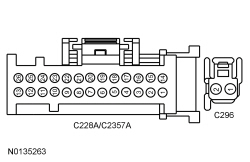
 | Yes
GO to F5 . No REPAIR the circuit. | ||||||||||||||||||||||||
| F5 CHECK THE SIGNAL RETURN CIRCUIT FOR AN OPEN | |||||||||||||||||||||||||

 | Yes
GO to F8 . No REPAIR the circuit. | ||||||||||||||||||||||||
| F6 CHECK THE EVAPORATOR TEMPERATURE SENSOR FEEDBACK CIRCUIT FOR A SHORT TO THE SIGNAL RETURN CIRCUIT | |||||||||||||||||||||||||
 | Yes
GO to F7 . No REPAIR the circuits. | ||||||||||||||||||||||||
| F7 CHECK THE EVAPORATOR TEMPERATURE SENSOR FEEDBACK CIRCUIT FOR A SHORT TO GROUND | |||||||||||||||||||||||||
 | Yes
GO to F8 . No REPAIR the circuit. | ||||||||||||||||||||||||
| F8 CHECK FOR CORRECT HVAC MODULE OPERATION | |||||||||||||||||||||||||
| Yes
CHECK OASIS for any applicable TSBs . If a TSB exists for this concern, DISCONTINUE this test and FOLLOW TSB instructions. If no TSB addresses this concern, INSTALL a new HVAC module. REFER to Section 412-01 . No The system is operating correctly at this time. The concern may have been caused by module connections. ADDRESS the root cause of any connector or pin issues. |
Pinpoint Test G: DTCs U3003:16 or 17
Diagnostics in this manual assume a certain skill level and knowledge of Ford-specific diagnostic practices. Refer to Diagnostic Methods in Section 100-00 for information about these practices.
Refer to Wiring Diagrams Cell 54 , Manual Climate Control System for schematic and connector information.
Refer to Wiring Diagrams Cell 55 , Automatic Climate Control System for schematic and connector information.
NOTE: DTC U3003 can be set if the vehicle has been recently jump started, the battery has been recently charged or the battery has been discharged. The battery may become discharged due to excessive load(s) on the charging system from aftermarket accessories or if the battery has been left unattended with the accessories on.
NOTE: Carry out a thorough inspection and verification before proceeding with the pinpoint test. Refer to Inspection and Verification in this section.
The HVAC module is supplied constant battery voltage and ground.
DTC Fault Trigger Conditions
| DTC | Description | Fault Trigger Conditions |
|---|---|---|
| U3003:16 | Battery Voltage: Circuit Voltage Below Threshold | This CMDTC sets when the HVAC module senses battery voltage is less than 8 volts for more than 10 seconds. |
| U3003:17 | Battery Voltage: Circuit Voltage Above Threshold | This CMDTC sets when the HVAC module senses battery voltage is greater than 16 volts for more than 10 seconds. |
| Test Step | Result / Action to Take | ||||||||||||||||||||||||
|---|---|---|---|---|---|---|---|---|---|---|---|---|---|---|---|---|---|---|---|---|---|---|---|---|---|
| G1 RETRIEVE PCM DTCs | |||||||||||||||||||||||||
| Yes
REFER to Section 414-00 for diagnosis of the battery and charging system. No GO to G2 . | ||||||||||||||||||||||||
| G2 CHECK BATTERY CONDITION | |||||||||||||||||||||||||
| Yes
GO to G3 . No INSTALL a new battery. REFER to Section 414-01 . | ||||||||||||||||||||||||
| G3 CHECK THE CHARGING SYSTEM VOLTAGE | |||||||||||||||||||||||||
NOTE: Do not allow the engine rpm to exceed 2,000 rpm while carrying out this step or the generator may self-excite, resulting in default charging system output voltage. If engine rpm has exceeded 2,000 rpm, shut the vehicle off and restart the engine before carrying out this step. 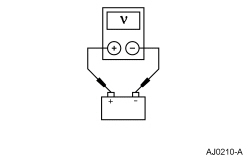 | Yes
For DTC U3003:16 , GO to G4 . For DTC U3003:17 , GO to G6 . No REFER to Section 414-00 to diagnose the charging system. | ||||||||||||||||||||||||
| G4 CHECK THE HVAC MODULE VOLTAGE SUPPLY CIRCUIT FOR HIGH RESISTANCE | |||||||||||||||||||||||||

 | Yes
GO to G5 . No REPAIR the circuit. | ||||||||||||||||||||||||
| G5 CHECK THE HVAC MODULE GROUND CIRCUIT FOR HIGH RESISTANCE | |||||||||||||||||||||||||

 | Yes
GO to G6 . No REPAIR the circuit. | ||||||||||||||||||||||||
| G6 CHECK FOR CORRECT HVAC MODULE OPERATION | |||||||||||||||||||||||||
| Yes
CHECK OASIS for any applicable TSBs . If a TSB exists for this concern, DISCONTINUE this test and FOLLOW TSB instructions. If no TSB addresses this concern, INSTALL a new HVAC module. REFER to Section 412-01 . No The system is operating correctly at this time. The concern may have been caused by module connections. ADDRESS the root cause of any connector or pin issues. |
Pinpoint Test H: Unable to Duplicate the Customer Concern and No DTCs Present
Diagnostics in this manual assume a certain skill level and knowledge of Ford-specific diagnostic practices. Refer to Diagnostic Methods in Section 100-00 for information about these practices.
This pinpoint test tests the functions of the HVAC system and identifies the correct HVAC symptom pinpoint test.
| Test Step | Result / Action to Take |
|---|---|
| H1 CHECK THE BLOWER MOTOR OPERATION | |
| Yes
GO to H2 . No If the blower motor does not operate in any setting, GO to Pinpoint Test Q . If the blower motor does not properly change speeds or shut off, GO to Pinpoint Test R . |
| H2 CHECK AIRFLOW OPERATION | |
| Yes
GO to H3 . No GO to Pinpoint Test J . |
| H3 VERIFY TEMPERATURE CONTROL OPERATION | |
| Yes
GO to H4 . No If the temperature does not get very warm, GO to Pinpoint Test K . For EMTC systems , If the temperature does not change at all, GO to Pinpoint Test O . For DATC systems , if the LH temperature does not change at all, GO to Pinpoint Test O . For DATC systems , if the RH temperature does not change at all, GO to Pinpoint Test P . |
| H4 VERIFY THE A/C CLUTCH DOES NOT ENGAGE WITH A/C OFF | |
| Yes
GO to H5 . No For EMTC systems , if the temperature is warmer than ambient temperature, GO to Pinpoint Test O and DIAGNOSE for inoperative blend door. For DATC systems , if the LH temperature is warmer than ambient temperature, GO to Pinpoint Test O and DIAGNOSE for inoperative blend door. For DATC systems , if the RH temperature is warmer than ambient temperature, GO to Pinpoint Test P and DIAGNOSE for inoperative blend door. If the outlet temperature is significantly colder than ambient temperature and the A/C compressor clutch cycles normally, GO to Pinpoint Test N . If the outlet temperature is significantly colder than ambient temperature and the A/C compressor clutch is engaged and does not cycle, GO to Pinpoint Test M . |
| H5 VERIFY A/C CLUTCH ENGAGEMENT IN THE A/C MODE | |
| Yes
GO to H6 . No GO to Pinpoint Test L . |
| H6 CHECK THE RECIRC OPERATION | |
| Yes
GO to H7 . No GO to Pinpoint Test I . |
| H7 CHECK THE AUXILIARY BLOWER MOTOR OPERATION | |
| Yes
GO to H8 . No If the auxiliary blower motor does not operate in any setting, GO to Pinpoint Test S . If the auxiliary blower motor does not properly change speeds or shut OFF using both the front and rear auxiliary controls, GO to Pinpoint Test T . If the auxiliary blower motor does not properly change speeds or shut OFF using the rear auxiliary controls only, GO to Pinpoint Test W . |
| H8 VERIFY AUXILIARY TEMPERATURE/MODE OPERATION | |
| Yes
For vehicles equipped with touchscreen controls, GO to H9 . For vehicles not equipped with touchscreen controls, the system is operating normally. No If the auxiliary temperature control is inoperative/does not operate correctly from the front/rear auxiliary controls, GO to Pinpoint Test U . If the auxiliary temperature control is inoperative/does not operate correctly from the front auxiliary controls only, INSTALL a new HVAC module. REFER To Section 412-01 . If the auxiliary temperature control is inoperative/does not operate correctly from the rear auxiliary controls only, GO to Pinpoint Test W . If the auxiliary panel/floor control is inoperative/does not operate correctly from the front/rear auxiliary controls, GO to Pinpoint Test V . If the auxiliary panel/floor control is inoperative/does not operate correctly from the front auxiliary controls only, INSTALL a new HVAC module. REFER to Section 412-01 . If the auxiliary panel/floor control is inoperative/does not operate correctly from the rear auxiliary controls only, GO to Pinpoint Test W . |
| H9 CHECK THE TOUCHSCREEN CONTROLS OPERATION | |
| Yes
The system is operating normally. No For 8 Inch (203mm) Touchscreen, 7 Speakers, REFER to Section 415-00B Symptom Chart. For Sony® Sound, 8 Inch (203mm) Touchscreen, 12 Speakers, REFER to Section 415-00C Symptom Chart. |
Pinpoint Test I: The Air Inlet Door is Inoperative
Diagnostics in this manual assume a certain skill level and knowledge of Ford-specific diagnostic practices. Refer to Diagnostic Methods in Section 100-00 for information about these practices.
Refer to Wiring Diagrams Cell 54 , Manual Climate Control System for schematic and connector information.
Refer to Wiring Diagrams Cell 55 , Automatic Climate Control System for schematic and connector information.
To rotate the air inlet mode door actuator, the HVAC module supplies voltage and ground to the air inlet mode door actuator through the door actuator motor circuits. To reverse the air inlet mode door actuator rotation, the HVAC module reverses the voltage and ground circuits. The air inlet mode door actuator feedback resistors are supplied a ground from the HVAC module by the air inlet mode door actuator return circuits and a 5-volt reference voltage on the air inlet mode door actuator reference circuits. The HVAC module reads the voltage on the air inlet mode door actuator feedback circuits to determine the air inlet mode door actuator position by the position of the actuator feedback resistor wiper arm.
DTC Fault Trigger Conditions
| DTC | Description | Fault Trigger Conditions |
|---|---|---|
| B1083:11 | Recirculation Damper Motor: Circuit Short to Ground | This CMDTC and on demand DTC sets when the HVAC module senses lower than expected voltage on an actuator motor circuit when voltage is applied to drive the motor, indicating a short to ground. |
| B1083:12 | Recirculation Damper Motor: Circuit Short to Battery | This CMDTC and on demand DTC sets when the HVAC module senses higher than expected voltage on the actuator motor circuit when ground is applied to drive the motor, indicating a short to voltage. |
| B1083:13 | Recirculation Damper Motor: Circuit Open | This CMDTC and on demand DTC sets when the HVAC module senses no voltage on the actuator motor circuit when ground is applied to drive the motor, indicating an open circuit. |
| B11F0:11 | Air Intake Damper Position Sensor: Circuit Short to Ground | This CMDTC and on demand DTC sets when the HVAC module senses less than 1 volt on the actuator feedback circuit, indicating a short to ground. |
| B11F0:15 | Air Intake Damper Position Sensor: Circuit Short to Battery or Open | This CMDTC and on demand DTC sets when the HVAC module senses greater than 4 volts on the actuator feedback circuit, indicating an open circuit or a short to voltage. |
NOTE: Access to the connector in the following step is difficult. Before carrying out this step, visually inspect the actuator and its harness for obvious damage. If no damage is evident, proceed with the test.
| Test Step | Result / Action to Take | ||||||||||||||||||||||||||||||||
|---|---|---|---|---|---|---|---|---|---|---|---|---|---|---|---|---|---|---|---|---|---|---|---|---|---|---|---|---|---|---|---|---|---|
| I1 CHECK THE HVAC MODULE FOR DTCs | |||||||||||||||||||||||||||||||||
| Yes
For DTC B1083:11 , GO to I3 . For DTC B1083:12 , GO to I4 . For DTC B1083:13 , GO to I6 . For DTC B11F0:11 , GO to I7 . For DTC B11F0:15 , GO to I9 . No GO to I2 . | ||||||||||||||||||||||||||||||||
| I2 CHECK THE AIR INLET MODE DOOR ACTUATOR OPERATION USING ACTIVE COMMANDS | |||||||||||||||||||||||||||||||||
| Yes
For 4.2 Inch (107mm) Screen, 4 or 6 Speakers, REFER to Section 415-00A Symptom Chart. For 8 Inch (203mm) Touchscreen, 7 Speakers, REFER to Section 415-00B Symptom Chart. For Sony® Sound, 8 Inch (203mm) Touchscreen, 12 Speakers, REFER to Section 415-00C Symptom Chart. No INSPECT for broken linkage or door. REPAIR as necessary. If no condition is found,GO to I14 . | ||||||||||||||||||||||||||||||||
| I3 CHECK THE AIR INLET MODE DOOR ACTUATOR MOTOR CIRCUITS FOR A SHORT TO GROUND | |||||||||||||||||||||||||||||||||

 | Yes
GO to I5 . No REPAIR the circuit in question. | ||||||||||||||||||||||||||||||||
| I4 CHECK THE AIR INLET MODE DOOR ACTUATOR MOTOR CIRCUITS FOR A SHORT TO VOLTAGE | |||||||||||||||||||||||||||||||||

 | Yes
REPAIR the circuit in question. No GO to I5 . | ||||||||||||||||||||||||||||||||
| I5 CHECK THE AIR INLET MODE DOOR ACTUATOR MOTOR CIRCUITS FOR A SHORT TOGETHER | |||||||||||||||||||||||||||||||||

 | Yes
GO to I14 . No REPAIR the circuits. | ||||||||||||||||||||||||||||||||
| I6 CHECK THE AIR INLET MODE DOOR ACTUATOR MOTOR CIRCUITS FOR AN OPEN | |||||||||||||||||||||||||||||||||
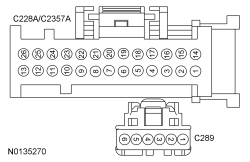
 | Yes
GO to I14 . No REPAIR the circuit in question. | ||||||||||||||||||||||||||||||||
| I7 CHECK THE AIR INLET MODE DOOR ACTUATOR FEEDBACK CIRCUIT FOR A SHORT TO GROUND | |||||||||||||||||||||||||||||||||

 | Yes
GO to I8 . No REPAIR the circuit. | ||||||||||||||||||||||||||||||||
| I8 CHECK THE SIGNAL RETURN CIRCUIT FOR A SHORT TO THE AIR INLET MODE DOOR ACTUATOR FEEDBACK CIRCUIT | |||||||||||||||||||||||||||||||||

 | Yes
GO to I14 . No REPAIR the circuits. | ||||||||||||||||||||||||||||||||
| I9 CHECK THE AIR INLET MODE DOOR ACTUATOR FEEDBACK CIRCUIT FOR A SHORT TO VOLTAGE | |||||||||||||||||||||||||||||||||

 | Yes
REPAIR the circuit. No GO to I10 . | ||||||||||||||||||||||||||||||||
| I10 CHECK THE REFERENCE VOLTAGE CIRCUIT FOR AN OPEN | |||||||||||||||||||||||||||||||||

 | Yes
GO to I11 . No REPAIR the circuit. | ||||||||||||||||||||||||||||||||
| I11 CHECK THE REFERENCE VOLTAGE CIRCUIT FOR A SHORT TO THE AIR INLET MODE DOOR ACTUATOR FEEDBACK CIRCUIT | |||||||||||||||||||||||||||||||||

 | Yes
GO to I12 . No REPAIR the circuits. | ||||||||||||||||||||||||||||||||
| I12 CHECK THE AIR INLET MODE DOOR ACTUATOR FEEDBACK CIRCUIT FOR AN OPEN | |||||||||||||||||||||||||||||||||

 | Yes
GO to I13 . No REPAIR the circuit. | ||||||||||||||||||||||||||||||||
| I13 CHECK THE AIR INLET MODE DOOR ACTUATOR RETURN CIRCUIT FOR AN OPEN | |||||||||||||||||||||||||||||||||

 | Yes
GO to I14 . No REPAIR the circuit. | ||||||||||||||||||||||||||||||||
| I14 CHECK FOR CORRECT HVAC MODULE OPERATION | |||||||||||||||||||||||||||||||||
| Yes
INSTALL a new air inlet mode door actuator. REFER to Section 412-01 . TEST the system for normal operation. If the concern is still present, GO to I15 . No The system is operating correctly at this time. The concern may have been caused by module connections. ADDRESS the root cause of any connector or pin issues. | ||||||||||||||||||||||||||||||||
| I15 MODULE ACTUATOR POSITION CALIBRATION | |||||||||||||||||||||||||||||||||
| Yes
CHECK OASIS for any applicable TSBs . If a TSB exists for this concern, DISCONTINUE this test and FOLLOW TSB instructions. If no TSB addresses this concern, INSTALL a new HVAC module. REFER to Section 412-01 . No The system is operating correctly at this time. The concern may have been caused by module connections. ADDRESS the root cause of any connector or pin issues. |
Pinpoint Test J: Incorrect/Erratic Direction of Airflow From Outlets
Diagnostics in this manual assume a certain skill level and knowledge of Ford-specific diagnostic practices. Refer to Diagnostic Methods in Section 100-00 for information about these practices.
Refer to Wiring Diagrams Cell 54 , Manual Climate Control System for schematic and connector information.
Refer to Wiring Diagrams Cell 55 , Automatic Climate Control System for schematic and connector information.
To rotate the defrost/panel/floor mode door actuator, the HVAC module supplies voltage and ground to the defrost/panel/floor mode door actuator motor through the actuator motor circuits. To reverse the defrost/panel/floor mode door actuator rotation, the HVAC module reverses the voltage and ground circuits.
The defrost/panel/floor mode door actuator feedback resistor is supplied a 5-volt reference voltage and ground from the HVAC module. The HVAC module measures the resistance on the defrost/panel/floor mode door actuator feedback circuit to determine the defrost/panel/floor mode door actuator position by the position of the actuator feedback resistor wiper arm.
During an actuator calibration cycle, the HVAC module drives the defrost/panel/floor mode door until the door reaches both internal stops in the HVAC case. If the defrost/panel/floor mode door is temporarily obstructed or binding during a calibration cycle, the HVAC module may interpret this as the actual end of travel for the door. When this condition occurs and the HVAC module commands the actuator to its end of travel, the airflow may not be from the expected outlets.
DTC Fault Trigger Conditions
| DTC | Description | Fault Trigger Conditions |
|---|---|---|
| B1086:11 | Air Distribution Damper Motor: Circuit Short to Ground | This CMDTC sets when the HVAC module senses lower than expected voltage on an actuator motor circuit when voltage is applied to drive the motor, indicating a short to ground. |
| B1086:12 | Air Distribution Damper Motor: Circuit Short to Battery | This CMDTC sets when the HVAC module senses greater than expected voltage on the actuator motor circuit when ground is applied to drive the motor, indicating a short to voltage. |
| B1086:13 | Air Distribution Damper Motor: Circuit Open | This CMDTC sets when the HVAC module senses no voltage on the actuator motor circuit when ground is applied to drive the motor, indicating an open circuit. |
| B11E7:11 | Air Distribution Damper Position Sensor: Circuit Short to Ground | This CMDTC sets when the HVAC module senses less than 1 volt on the actuator feedback circuit, indicating a short to ground. |
| B11E7:15 | Air Distribution Damper Position Sensor: Circuit Short to Battery or Open | This CMDTC sets when the HVAC module senses greater than 4 volts on the actuator feedback circuit, indicating an open circuit or a short to voltage. |
NOTE: Access to the defrost/panel/floor mode door actuator motor connector in this pinpoint test is difficult. Before disconnecting the defrost/panel/floor mode door actuator motor connector, visually inspect the actuator and its harness for obvious damage. If no damage is evident, proceed with the test.
| Test Step | Result / Action to Take | ||||||||||||||||||||||||||||||||
|---|---|---|---|---|---|---|---|---|---|---|---|---|---|---|---|---|---|---|---|---|---|---|---|---|---|---|---|---|---|---|---|---|---|
| J1 CHECK THE HVAC MODULE FOR DTCs | |||||||||||||||||||||||||||||||||
| Yes
For DTC B1086:11 , GO to J3 . For DTC B1086:12 , GO to J4 . For DTC B1086:13 , GO to J6 . For DTC B11E7:11 , GO to J7 . For DTC B11E7:15 , GO to J9 . No GO to J2 . | ||||||||||||||||||||||||||||||||
| J2 CHECK THE DEFROST/PANEL/FLOOR MODE DOOR ACTUATOR OPERATION USING ACTIVE COMMANDS | |||||||||||||||||||||||||||||||||
| Yes
For 4.2 Inch (107mm) Screen, 4 or 6 Speakers, REFER to Section 415-00A Symptom Chart. For 8 Inch (203mm) Touchscreen, 7 Speakers, REFER to Section 415-00B Symptom Chart. For Sony® Sound, 8 Inch (203mm) Touchscreen, 12 Speakers, REFER to Section 415-00C Symptom Chart. No INSPECT for broken linkage or door. REPAIR as necessary. If no condition is found, GO to J14 . | ||||||||||||||||||||||||||||||||
| J3 CHECK THE DEFROST/PANEL/FLOOR MODE DOOR ACTUATOR MOTOR CIRCUITS FOR A SHORT TO GROUND | |||||||||||||||||||||||||||||||||

 | Yes
GO to J5 . No REPAIR the circuit in question. | ||||||||||||||||||||||||||||||||
| J4 CHECK THE DEFROST/PANEL/FLOOR MODE DOOR ACTUATOR MOTOR CIRCUITS FOR A SHORT TO VOLTAGE | |||||||||||||||||||||||||||||||||

 | Yes
REPAIR the circuit in question. No GO to J5 . | ||||||||||||||||||||||||||||||||
| J5 CHECK THE DEFROST/PANEL/FLOOR MODE DOOR ACTUATOR MOTOR CIRCUITS FOR A SHORT TOGETHER | |||||||||||||||||||||||||||||||||

 | Yes
GO to J14 . No REPAIR the circuits. | ||||||||||||||||||||||||||||||||
| J6 CHECK THE DEFROST/PANEL/FLOOR MODE DOOR ACTUATOR MOTOR CIRCUITS FOR AN OPEN | |||||||||||||||||||||||||||||||||
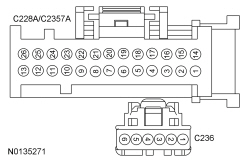
 | Yes
GO to J14 . No REPAIR the circuit in question. | ||||||||||||||||||||||||||||||||
| J7 CHECK THE DEFROST/PANEL/FLOOR MODE DOOR ACTUATOR FEEDBACK CIRCUIT FOR A SHORT TO GROUND | |||||||||||||||||||||||||||||||||

 | Yes
GO to J8 . No REPAIR the circuit. | ||||||||||||||||||||||||||||||||
| J8 CHECK THE SIGNAL RETURN CIRCUIT FOR A SHORT TO THE DEFROST/PANEL/FLOOR MODE DOOR ACTUATOR FEEDBACK CIRCUIT | |||||||||||||||||||||||||||||||||

 | Yes
GO to J14 . No REPAIR the circuits. | ||||||||||||||||||||||||||||||||
| J9 CHECK THE DEFROST/PANEL/FLOOR MODE DOOR ACTUATOR FEEDBACK CIRCUIT FOR A SHORT TO VOLTAGE | |||||||||||||||||||||||||||||||||

 | Yes
REPAIR the circuit. No GO to J10 . | ||||||||||||||||||||||||||||||||
| J10 CHECK THE REFERENCE VOLTAGE CIRCUIT FOR AN OPEN | |||||||||||||||||||||||||||||||||

 | Yes
GO to J11 . No REPAIR the circuit. | ||||||||||||||||||||||||||||||||
| J11 CHECK THE REFERENCE VOLTAGE CIRCUIT FOR A SHORT TO THE DEFROST/PANEL/FLOOR MODE DOOR ACTUATOR FEEDBACK CIRCUIT | |||||||||||||||||||||||||||||||||

 | Yes
GO to J12 . No REPAIR the circuits. | ||||||||||||||||||||||||||||||||
| J12 CHECK THE DEFROST/PANEL/FLOOR MODE DOOR ACTUATOR FEEDBACK CIRCUIT FOR AN OPEN | |||||||||||||||||||||||||||||||||

 | Yes
GO to J13 . No REPAIR the circuit. | ||||||||||||||||||||||||||||||||
| J13 CHECK THE DEFROST/PANEL/FLOOR MODE DOOR ACTUATOR RETURN CIRCUIT FOR AN OPEN | |||||||||||||||||||||||||||||||||

 | Yes
GO to J14 . No REPAIR the circuit. | ||||||||||||||||||||||||||||||||
| J14 CHECK FOR CORRECT DEFROST/PANEL/FLOOR MODE DOOR ACTUATOR OPERATION | |||||||||||||||||||||||||||||||||
| Yes
INSTALL a new defrost/panel/floor mode door actuator. REFER to Section 412-01 . TEST the system for normal operation. If the concern is still present, GO to J15 . No The system is operating correctly at this time. The concern may have been caused by module connections. ADDRESS the root cause of any connector or pin issues. | ||||||||||||||||||||||||||||||||
| J15 MODULE ACTUATOR POSITION CALIBRATION | |||||||||||||||||||||||||||||||||
NOTE: The purpose of the module actuator position calibration is to allow the HVAC module to reinitialize and calibrate the actuator stop points. | Yes
CHECK OASIS for any applicable TSBs . If a TSB exists for this concern, DISCONTINUE this test and FOLLOW TSB instructions. If no TSB addresses this concern, INSTALL a new HVAC module. REFER to Section 412-01 . No The system is now operating correctly at this time. The concern may have been caused by a foreign object in the HVAC case or temporary binding that restricted actuator door travel. CHECK any actuator external linkage. If the condition recurs, INSPECT actuator linkage and door for binding and CHECK HVAC case for foreign objects. |
Pinpoint Test K: Insufficient, Erratic or No Heat
Diagnostics in this manual assume a certain skill level and knowledge of Ford-specific diagnostic practices. Refer to Diagnostic Methods in Section 100-00 for information about these practices.
Warm coolant flows from the engine through the heater core and back to the engine. Proper coolant temperatures are critical for good heater performance.
| Test Step | Result / Action to Take |
|---|---|
| K1 CHECK FOR CORRECT ENGINE COOLANT LEVEL | |
| Yes
GO to K3 . No GO to K2 . |
| K2 CHECK THE ENGINE COOLING SYSTEM FOR LEAKS | |
| Yes
REPAIR the engine coolant leak. No FILL and BLEED the cooling system. REFER to Section 303-03 . After filling and bleeding the cooling system, GO to K3 . |
| K3 CHECK FOR COOLANT FLOW TO THE HEATER CORE | |
| Yes
GO to K4 . No REFER to Section 303-03 to check cooling system function. |
| K4 CHECK FOR A PLUGGED OR RESTRICTED HEATER CORE | |
| Yes
For EMTC systems , GO to Pinpoint Test O and DIAGNOSE for inoperative blend door. For DATC systems , if the LH temperature is not hot, GO to Pinpoint Test O and DIAGNOSE for inoperative LH blend door. For DATC systems , if the RH temperature is not hot, GO to Pinpoint Test P and DIAGNOSE for inoperative RH blend door. No INSTALL a new heater core. REFER to Section 412-01 . |
Pinpoint Test L: The Air Conditioning (A/C) is Inoperative
Diagnostics in this manual assume a certain skill level and knowledge of Ford-specific diagnostic practices. Refer to Diagnostic Methods in Section 100-00 for information about these practices.
Refer to Wiring Diagrams Cell 54 , Manual Climate Control System for schematic and connector information.
Refer to Wiring Diagrams Cell 55 , Automatic Climate Control System for schematic and connector information.
When the A/C is requested, the FCIM sends the button press message over the I-CAN to the IPC . The IPC sends the button press message to the BCM over the HS-CAN . The BCM sends the button press message to the HVAC module over the MS-CAN . The HVAC module sends an A/C request message through the MS-CAN to the BCM and the BCM sends the A/C request through the HS-CAN to the PCM.
Voltage is provided to the A/C clutch relay coil and switch contacts. When A/C is requested and A/C line pressures allow, a ground is provided to the A/C clutch relay coil from the PCM, energizing the A/C clutch relay. When the PCM energizes the relay, voltage is supplied to the A/C compressor clutch field coil from the relay. Ground is supplied for the A/C compressor clutch field coil.
The evaporator temperature sensor is used for A/C compressor cycling. An accurate evaporator temperature is critical for compressor engagement. The PCM uses the temperature measurement to turn the A/C compressor off before the evaporator temperatures are cold enough to freeze the condensation on the evaporator core.
When an A/C request is received by the PCM, the A/C compressor clutch only engages through the A/C clutch relay if all of the following conditions are met:
| Test Step | Result / Action to Take | ||||||||||||
|---|---|---|---|---|---|---|---|---|---|---|---|---|---|
| L1 CHECK THE A/C SYSTEM PRESSURE | |||||||||||||
| Yes
GO to L2 . No CHECK the A/C system for leaks. REFER to Fluorescent Dye Leak Detection or Electronic Leak Detection in this section. RECHARGE the A/C system. REFER to Air Conditioning (A/C) System Recovery, Evacuation and Charging . | ||||||||||||
| L2 CHECK THE A/C PRESSURE SENSOR (ACP_PRESS) PID | |||||||||||||
| Yes
GO to L3 . No INSTALL a new A/C pressure transducer. | ||||||||||||
| L3 CHECK THE A/C EVAPORATOR TEMPERATURE (EVAP_TEMP) PID | |||||||||||||
| Yes
GO to L4 . No INSTALL a new evaporator temperature sensor (part of 19850). REFER to Section 412-01 , Heater Core And Evaporator Core Housing procedure. | ||||||||||||
| L4 CHECK THE (A/C) SWITCH (CC_SW_AC) PID WITH THE A/C ON | |||||||||||||
| Yes
GO to L5 . No For 4.2 Inch (107mm) Screen, 4 or 6 Speakers, REFER to Section 415-00A Symptom Chart. For 8 Inch (203mm) Touchscreen, 7 Speakers, REFER to Section 415-00B Symptom Chart. For Sony® Sound, 8 Inch (203mm) Touchscreen, 12 Speakers, REFER to Section 415-00C Symptom Chart. | ||||||||||||
| L5 CHECK THE AIR CONDITIONING REQUEST SIGNAL (AC_REQ) PID WITH THE A/C ON | |||||||||||||
| Yes
GO to L6 . No GO to L12 . | ||||||||||||
| L6 CHECK THE AIR CONDITIONING COMPRESSOR COMMANDED STATE (ACC_CMD) PID WITH THE A/C ON | |||||||||||||
| Yes
GO to L13 . No GO to L7 . | ||||||||||||
| L7 CHECK THE VOLTAGE TO THE A/C CLUTCH RELAY | |||||||||||||
 | Yes
GO to L8 . No VERIFY BJB fuse 62 (10A) is OK. If OK, REPAIR the circuit. If not OK, REFER to the Wiring Diagrams manual to identify the possible causes of the circuit short. | ||||||||||||
| L8 BYPASS THE A/C CLUTCH RELAY | |||||||||||||
 | Yes
REMOVE the jumper wire. INSTALL a new A/C clutch relay. No LEAVE the jumper wire installed. GO to L9 . | ||||||||||||
| L9 CHECK THE A/C COMPRESSOR CLUTCH FIELD COIL VOLTAGE SUPPLY CIRCUIT FOR AN OPEN | |||||||||||||
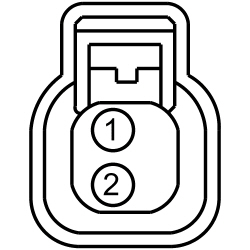 | Yes
REMOVE the jumper wire. GO to L10 . No REMOVE the jumper wire. REPAIR the circuit. | ||||||||||||
| L10 CHECK THE A/C COMPRESSOR CLUTCH FIELD COIL GROUND CIRCUIT FOR AN OPEN | |||||||||||||
 | Yes
GO to L11 . No REPAIR the circuit. | ||||||||||||
| L11 CHECK THE A/C COMPRESSOR CLUTCH AIR GAP | |||||||||||||
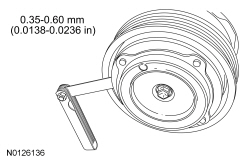 | Yes
ADJUST the A/C compressor clutch air gap. REFER to Air Conditioning (A/C) Clutch Air Gap Adjustment . No INSTALL a new A/C compressor. REFER to Section 412-01 . | ||||||||||||
| L12 CHECK FOR CORRECT HVAC MODULE OPERATION | |||||||||||||
| Yes
CHECK OASIS for any applicable TSBs . If a TSB exists for this concern, DISCONTINUE this test and FOLLOW TSB instructions. If no TSB addresses this concern, INSTALL a new HVAC module. REFER to Section 412-01 . No The system is operating correctly at this time. The concern may have been caused by module connections. ADDRESS the root cause of any connector or pin issues. | ||||||||||||
| L13 CHECK FOR CORRECT PCM OPERATION | |||||||||||||
| Yes
CHECK OASIS for any applicable TSBs . If a TSB exists for this concern, DISCONTINUE this test and FOLLOW TSB instructions. If no TSB addresses this concern, INSTALL a new PCM. REFER to Section 303-14 . No The system is operating correctly at this time. The concern may have been caused by module connections. ADDRESS the root cause of any connector or pin issues. |
Pinpoint Test M: The Air Conditioning (A/C) is Always On — A/C Compressor Does Not Cycle
Diagnostics in this manual assume a certain skill level and knowledge of Ford-specific diagnostic practices. Refer to Diagnostic Methods in Section 100-00 for information about these practices.
Refer to Wiring Diagrams Cell 54 , Manual Climate Control System for schematic and connector information.
Refer to Wiring Diagrams Cell 55 , Automatic Climate Control System for schematic and connector information.
When the A/C is requested, the FCIM sends the button press message over the I-CAN to the IPC . The IPC sends the button press message to the BCM over the HS-CAN . The BCM sends the button press message to the HVAC module over the MS-CAN . The HVAC module sends an A/C request message through the MS-CAN to the BCM and the BCM sends the A/C request through the HS-CAN to the PCM.
Voltage is provided to the A/C clutch relay coil and switch contacts. When A/C is requested and A/C line pressures allow, a ground is provided to the A/C clutch relay coil from the PCM, energizing the A/C clutch relay. When the PCM energizes the relay, voltage is supplied to the A/C compressor clutch field coil from the relay. Ground is supplied for the A/C compressor clutch field coil.
The evaporator temperature sensor is used for A/C compressor cycling. An accurate evaporator temperature is critical for compressor engagement. The PCM uses the temperature measurement to turn the A/C compressor off before the evaporator temperatures are cold enough to freeze the condensation on the evaporator core.
| Test Step | Result / Action to Take | ||||||||||||
|---|---|---|---|---|---|---|---|---|---|---|---|---|---|
| M1 CHECK THE PCM FOR DTCs | |||||||||||||
| Yes
REFER to GO to Pinpoint Test B . No GO to M2 . | ||||||||||||
| M2 CHECK FOR A/C CLUTCH OPERATION WITH THE A/C CLUTCH RELAY DISCONNECTED | |||||||||||||
| Yes
GO to M3 . No GO to M5 . | ||||||||||||
| M3 CHECK THE POWER CIRCUIT TO THE A/C COMPRESSOR CLUTCH FOR A SHORT TO POWER | |||||||||||||
 | Yes
REPAIR the circuit. No GO to M4 . | ||||||||||||
| M4 CHECK THE A/C COMPRESSOR CLUTCH AIR GAP | |||||||||||||
 | Yes
ADJUST the A/C compressor clutch air gap. REFER to Air Conditioning (A/C) Clutch Air Gap Adjustment . No INSTALL a new A/C compressor. REFER to Section 412-01 . | ||||||||||||
| M5 CHECK THE A/C CLUTCH RELAY FUNCTIONALITY | |||||||||||||
| Yes
INSTALL a new A/C clutch relay. No GO to M6 . | ||||||||||||
| M6 CHECK FOR CORRECT PCM OPERATION | |||||||||||||
| Yes
CHECK OASIS for any applicable TSBs . If a TSB exists for this concern, DISCONTINUE this test and FOLLOW TSB instructions. If no TSB addresses this concern, INSTALL a new PCM. REFER to Section 303-14 . No The system is operating correctly at this time. The concern may have been caused by module connections. ADDRESS the root cause of any connector or pin issues. |
Pinpoint Test N: The Air Conditioning (A/C) is Always On — A/C Mode Always Commanded ON
Diagnostics in this manual assume a certain skill level and knowledge of Ford-specific diagnostic practices. Refer to Diagnostic Methods in Section 100-00 for information about these practices.
Refer to Wiring Diagrams Cell 54 , Manual Climate Control System for schematic and connector information.
Refer to Wiring Diagrams Cell 55 , Automatic Climate Control System for schematic and connector information.
When the A/C is requested, the FCIM sends the button press message over the I-CAN to the IPC . The IPC then sends the button press message to the BCM over the HS-CAN . The BCM sends the button press message to the HVAC module over the MS-CAN . The HVAC module sends an A/C request message through the MS-CAN to the BCM and the BCM sends the A/C request through the HS-CAN to the PCM.
DTC Fault Trigger Conditions
| DTC | Description | Fault Trigger Conditions |
|---|---|---|
| P1464 | A/C Demand Out Of Self Test Range: No Sub Type Information | This DTC sets when the PCM senses an A/C request during a PCM self-test. |
| Test Step | Result / Action to Take |
|---|---|
| N1 CHECK THE A/C SWITCH STATUS (CC_SW_AC) PID WITH THE A/C OFF | |
| Yes
GO to N2 . No For 4.2 Inch (107mm) Screen, 4 or 6 Speakers, REFER to Section 415-00A Symptom Chart. For 8 Inch (203mm) Touchscreen, 7 Speakers, REFER to Section 415-00B Symptom Chart. For Sony® Sound, 8 Inch (203mm) Touchscreen, 12 Speakers, REFER to Section 415-00C Symptom Chart. |
| N2 CHECK THE AIR CONDITIONING REQUEST SIGNAL (AC_REQ) PID WITH THE A/C OFF | |
| Yes
GO to N4 . No GO to N3 . |
| N3 CHECK THE AIR CONDITIONING REQUEST SIGNAL (AC_REQ) PID WITH HVAC MODULE DISCONNECTED | |
| Yes
GO to N4 . No GO to N5 . |
| N4 CHECK FOR CORRECT HVAC MODULE OPERATION | |
| Yes
CHECK OASIS for any applicable TSBs . If a TSB exists for this concern, DISCONTINUE this test and FOLLOW TSB instructions. If no TSB addresses this concern, INSTALL a new HVAC module. REFER to Section 412-01 . No The system is operating correctly at this time. The concern may have been caused by module connections. ADDRESS the root cause of any connector or pin issues. |
| N5 CHECK FOR CORRECT PCM OPERATION | |
| Yes
CHECK OASIS for any applicable TSBs . If a TSB exists for this concern, DISCONTINUE this test and FOLLOW TSB instructions. If no TSB addresses this concern, INSTALL a new PCM. REFER to Section 303-14 . No The system is operating correctly at this time. The concern may have been caused by module connections. ADDRESS the root cause of any connector or pin issues. |
Pinpoint Test O: Temperature Control is Inoperative/Does Not Operate Correctly — LH
Diagnostics in this manual assume a certain skill level and knowledge of Ford-specific diagnostic practices. Refer to Diagnostic Methods in Section 100-00 for information about these practices.
Refer to Wiring Diagrams Cell 54 , Manual Climate Control System for schematic and connector information.
Refer to Wiring Diagrams Cell 55 , Automatic Climate Control System for schematic and connector information.
To rotate the temperature blend door actuator, the HVAC module supplies voltage and ground to the temperature blend door actuator through the door actuator motor circuits. To reverse the temperature blend door actuator rotation, the HVAC module reverses the voltage and ground circuits.
The temperature blend door actuator feedback resistors are supplied a ground from the HVAC module by the temperature blend door actuator return circuits and a 5-volt reference voltage on the temperature blend door actuator reference circuits. The HVAC module reads the voltage on the temperature blend door actuator feedback circuits to determine the temperature blend door actuator position by the position of the actuator feedback resistor wiper arm.
During an actuator calibration cycle, the HVAC module drives the temperature blend door until the door reaches both internal stops in the HVAC case. If the temperature blend door is temporarily obstructed or binding during a calibration cycle, the HVAC module may interpret this as the actual end of travel for the door. When this condition occurs and the HVAC module commands the actuator to its end of travel, the airflow may not be the expected temperature.
DTC Fault Trigger Conditions
| DTC | Description | Fault Trigger Conditions |
|---|---|---|
| B1081:11 | Left Temperature Damper Motor: Circuit Short to Ground | This CMDTC sets when the HVAC module senses lower the expected voltage on an actuator motor circuit when voltage is applied to drive the motor, indicating a short to ground. |
| B1081:12 | Left Temperature Damper Motor: Circuit Short to Battery | This CMDTC sets when the HVAC module senses higher than expected voltage on the actuator motor circuit when ground is applied to drive the motor, indicating a short to voltage. |
| B1081:13 | Left Temperature Damper Motor: Circuit Open | This CMDTC sets when the HVAC module senses no voltage on the actuator motor circuit when ground is applied to drive the motor, indicating an open circuit. |
| B11E5:11 | Left HVAC Damper Position Sensor: Circuit Short to Ground | This CMDTC sets when the HVAC module senses less than 1 volt on the actuator feedback circuit, indicating a short to ground. |
| B11E5:15 | Left HVAC Damper Position Sensor: Circuit Short to Battery or Open | This CMDTC sets when the HVAC module senses greater than 4 volts on the actuator feedback circuit, indicating an open circuit or a short to voltage. |
| Test Step | Result / Action to Take | ||||||||||||||||||||||||||||||||
|---|---|---|---|---|---|---|---|---|---|---|---|---|---|---|---|---|---|---|---|---|---|---|---|---|---|---|---|---|---|---|---|---|---|
| O1 CHECK THE HVAC MODULE FOR DTCs | |||||||||||||||||||||||||||||||||
| Yes
For DTC B1081:11, GO to O3 . For DTC B1081:12, GO to O4 . For DTC B1081:13, GO to O5 . For DTC B11E5:11, GO to O7 . For DTC B11E5:15, GO to O9 . No GO to O2 . | ||||||||||||||||||||||||||||||||
| O2 CHECK THE LH TEMPERATURE BLEND DOOR ACTUATOR OPERATION USING ACTIVE COMMANDS | |||||||||||||||||||||||||||||||||
| Yes
For 4.2 Inch (107mm) Screen, 4 or 6 Speakers, REFER to Section 415-00A Symptom Chart. For 8 Inch (203mm) Touchscreen, 7 Speakers, REFER to Section 415-00B Symptom Chart. For Sony® Sound, 8 Inch (203mm) Touchscreen, 12 Speakers, REFER to Section 415-00C Symptom Chart. No INSPECT for broken linkage or door. REPAIR as necessary. If no condition is found, GO to O14 . | ||||||||||||||||||||||||||||||||
| O3 CHECK THE LH TEMPERATURE BLEND DOOR ACTUATOR MOTOR CIRCUITS FOR A SHORT TO GROUND | |||||||||||||||||||||||||||||||||
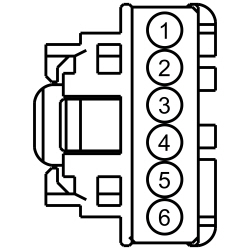 | Yes
GO to O6 . No REPAIR the circuit in question. | ||||||||||||||||||||||||||||||||
| O4 CHECK THE LH TEMPERATURE BLEND DOOR ACTUATOR MOTOR CIRCUITS FOR A SHORT TO VOLTAGE | |||||||||||||||||||||||||||||||||
 | Yes
REPAIR the circuit in question. No GO to O6 . | ||||||||||||||||||||||||||||||||
| O5 CHECK THE LH TEMPERATURE BLEND DOOR ACTUATOR MOTOR CIRCUITS FOR AN OPEN | |||||||||||||||||||||||||||||||||
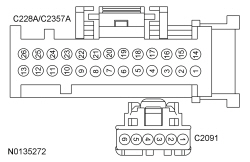
| Yes
GO to O14 . No REPAIR the circuit in question. | ||||||||||||||||||||||||||||||||
| O6 CHECK THE LH TEMPERATURE BLEND DOOR ACTUATOR MOTOR CIRCUITS FOR A SHORT TOGETHER | |||||||||||||||||||||||||||||||||
 | Yes
GO to O14 . No REPAIR the circuit. | ||||||||||||||||||||||||||||||||
| O7 CHECK THE LH TEMPERATURE BLEND DOOR ACTUATOR FEEDBACK CIRCUIT FOR A SHORT TO GROUND | |||||||||||||||||||||||||||||||||
 | Yes
GO to O8 . No REPAIR the circuit. | ||||||||||||||||||||||||||||||||
| O8 CHECK THE SIGNAL RETURN CIRCUIT FOR A SHORT TO THE LH TEMPERATURE BLEND DOOR ACTUATOR FEEDBACK CIRCUIT | |||||||||||||||||||||||||||||||||
 | Yes
GO to O14 . No REPAIR the circuits. | ||||||||||||||||||||||||||||||||
| O9 CHECK THE LH TEMPERATURE BLEND DOOR ACTUATOR FEEDBACK CIRCUIT FOR A SHORT TO VOLTAGE | |||||||||||||||||||||||||||||||||
 | Yes
REPAIR the circuits. No GO to O10 . | ||||||||||||||||||||||||||||||||
| O10 CHECK THE REFERENCE VOLTAGE CIRCUIT FOR AN OPEN | |||||||||||||||||||||||||||||||||

 | Yes
GO to O11 . No REPAIR the circuit. | ||||||||||||||||||||||||||||||||
| O11 CHECK THE REFERENCE VOLTAGE CIRCUIT FOR A SHORT TO THE LH TEMPERATURE BLEND DOOR ACTUATOR FEEDBACK CIRCUIT | |||||||||||||||||||||||||||||||||
 | Yes
GO to O12 . No REPAIR the circuits. | ||||||||||||||||||||||||||||||||
| O12 CHECK THE LH TEMPERATURE BLEND DOOR ACTUATOR FEEDBACK CIRCUIT FOR AN OPEN | |||||||||||||||||||||||||||||||||

 | Yes
GO to O13 . No REPAIR the circuit. | ||||||||||||||||||||||||||||||||
| O13 CHECK THE LH TEMPERATURE BLEND DOOR ACTUATOR SIGNAL RETURN CIRCUIT FOR AN OPEN | |||||||||||||||||||||||||||||||||

 | Yes
GO to O14 . No REPAIR the circuit. | ||||||||||||||||||||||||||||||||
| O14 CHECK FOR CORRECT LH TEMPERATURE BLEND DOOR ACTUATOR OPERATION | |||||||||||||||||||||||||||||||||
| Yes
INSTALL a new LH temperature blend door actuator, REFER to Section 412-01 Temperature Blend Door Actuator - LH. TEST the system for normal operation. If the concern is still present, GO to O15 . No The system is operating correctly at this time. The concern may have been caused by module connections. ADDRESS the root cause of any connector or pin issues. | ||||||||||||||||||||||||||||||||
| O15 MODULE ACTUATOR POSITION CALIBRATION | |||||||||||||||||||||||||||||||||
NOTE: The purpose of the module actuator position calibration is to allow the HVAC module to reinitialize and calibrate the actuator stop points. | Yes
CHECK OASIS for any applicable TSBs . If a TSB exists for this concern, DISCONTINUE this test and FOLLOW TSB instructions. If no TSB addresses this concern, INSTALL a new HVAC module. REFER to Section 412-01 . No The system is now operating correctly at this time. The concern may have been caused by a foreign object in the HVAC case or temporary binding that restricted actuator door travel. CHECK any actuator external linkage. If condition recurs, INSPECT actuator linkage and door for binding and CHECK HVAC case for foreign objects. |
Pinpoint Test P: Temperature Control is Inoperative/Does Not Operate Correctly — RH
Diagnostics in this manual assume a certain skill level and knowledge of Ford-specific diagnostic practices. Refer to Diagnostic Methods in Section 100-00 for information about these practices.
Refer to Wiring Diagrams Cell 55 , Automatic Climate Control System for schematic and connector information.
To rotate the temperature blend door actuator, the HVAC module supplies voltage and ground to the temperature blend door actuator through the door actuator motor circuits. To reverse the temperature blend door actuator rotation, the HVAC module reverses the voltage and ground circuits.
The temperature blend door actuator feedback resistors are supplied a ground from the HVAC module by the temperature blend door actuator return circuits and a 5-volt reference voltage on the temperature blend door actuator reference circuits. The HVAC module reads the voltage on the temperature blend door actuator feedback circuits to determine the temperature blend door actuator position by the position of the actuator feedback resistor wiper arm.
During an actuator calibration cycle, the HVAC module drives the temperature blend door until the door reaches both internal stops in the HVAC case. If the temperature blend door is temporarily obstructed or binding during a calibration cycle, the HVAC module may interpret this as the actual end of travel for the door. When this condition occurs and the HVAC module commands the actuator to its end of travel, the airflow may not be the expected temperature.
DTC Fault Trigger Conditions
| DTC | Description | Fault Trigger Conditions |
|---|---|---|
| B1082:11 | Right Temperature Damper Motor: Circuit Short to Ground | This CMDTC sets when the HVAC module senses lower the expected voltage on an actuator motor circuit when voltage is applied to drive the motor, indicating a short to ground. |
| B1082:12 | Right Temperature Damper Motor: Circuit Short to Battery | This CMDTC sets when the HVAC module senses higher than expected voltage on the actuator motor circuit when ground is applied to drive the motor, indicating a short to voltage. |
| B1082:13 | Right Temperature Damper Motor: Circuit Open | This CMDTC sets when the HVAC module senses no voltage on the actuator motor circuit when ground is applied to drive the motor, indicating an open circuit. |
| B11E6:11 | Right HVAC Damper Position Sensor: Circuit Short to Ground | This CMDTC sets when the HVAC module senses less than 1 volt on the actuator feedback circuit, indicating a short to ground. |
| B11E6:15 | Right HVAC Damper Position Sensor: Circuit Short to Battery or Open | This CMDTC sets when the HVAC module senses greater than 4 volts on the actuator feedback circuit, indicating an open circuit or a short to voltage. |
| Test Step | Result / Action to Take | ||||||||||||||||
|---|---|---|---|---|---|---|---|---|---|---|---|---|---|---|---|---|---|
| P1 CHECK THE HVAC MODULE FOR DTCs | |||||||||||||||||
| Yes
For DTC B1082:11, GO to P3 . For DTC B1082:12, GO to P4 . For DTC B1082:13, GO to P5 . For DTC B11E6:11, GO to P7 . For DTC B11E6:15, GO to P9 . No GO to P2 . | ||||||||||||||||
| P2 CHECK THE RH TEMPERATURE BLEND DOOR ACTUATOR OPERATION USING ACTIVE COMMANDS | |||||||||||||||||
| Yes
For 4.2 Inch (107mm) Screen, 4 or 6 Speakers, REFER to Section 415-00A Symptom Chart. For 8 Inch (203mm) Touchscreen, 7 Speakers, REFER to Section 415-00B Symptom Chart. For Sony® Sound, 8 Inch (203mm) Touchscreen, 12 Speakers, REFER to Section 415-00C Symptom Chart. No INSPECT for broken linkage or door. REPAIR as necessary. If no condition is found, GO to P14 . | ||||||||||||||||
| P3 CHECK THE RH TEMPERATURE BLEND DOOR ACTUATOR MOTOR CIRCUITS FOR A SHORT TO GROUND | |||||||||||||||||
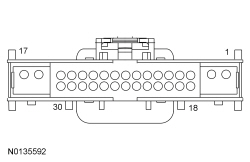 | Yes
GO to P6 . No REPAIR the circuit in question. | ||||||||||||||||
| P4 CHECK THE RH TEMPERATURE BLEND DOOR ACTUATOR MOTOR CIRCUITS FOR A SHORT TO VOLTAGE | |||||||||||||||||
 | Yes
REPAIR the circuit in question. No GO to P6 . | ||||||||||||||||
| P5 CHECK THE RH TEMPERATURE BLEND DOOR ACTUATOR MOTOR CIRCUITS FOR AN OPEN | |||||||||||||||||
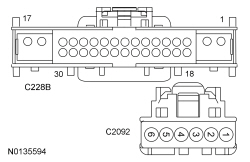 | Yes
GO to P14 . No REPAIR the circuit in question. | ||||||||||||||||
| P6 CHECK THE RH TEMPERATURE BLEND DOOR ACTUATOR MOTOR CIRCUITS FOR A SHORT TOGETHER | |||||||||||||||||
NOTE: Access to the connector in the following step is difficult. Before carrying out this step, visually inspect the actuator and its harness for obvious damage. If no damage is evident, proceed with the test.
 | Yes
GO to P14 . No REPAIR the circuits. | ||||||||||||||||
| P7 CHECK THE RH TEMPERATURE BLEND DOOR ACTUATOR FEEDBACK CIRCUIT FOR A SHORT TO GROUND | |||||||||||||||||
 | Yes
GO to P8 . No REPAIR the circuit. | ||||||||||||||||
| P8 CHECK THE SIGNAL RETURN CIRCUIT FOR A SHORT TO THE RH TEMPERATURE BLEND DOOR ACTUATOR FEEDBACK CIRCUIT | |||||||||||||||||
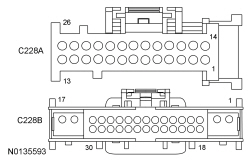 | Yes
GO to P14 . No REPAIR the circuits. | ||||||||||||||||
| P9 CHECK THE RH TEMPERATURE BLEND DOOR ACTUATOR FEEDBACK CIRCUIT FOR A SHORT TO VOLTAGE | |||||||||||||||||
 | Yes
REPAIR the circuit. No GO to P10 . | ||||||||||||||||
| P10 CHECK THE REFERENCE VOLTAGE CIRCUIT FOR AN OPEN | |||||||||||||||||
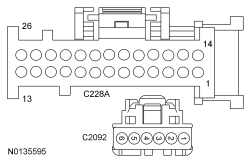 | Yes
GO to P11 . No REPAIR the circuit. | ||||||||||||||||
| P11 CHECK THE REFERENCE VOLTAGE CIRCUIT FOR A SHORT TO THE RH TEMPERATURE BLEND DOOR ACTUATOR FEEDBACK CIRCUIT | |||||||||||||||||
 | Yes
GO to P12 . No REPAIR the circuits. | ||||||||||||||||
| P12 CHECK THE RH TEMPERATURE BLEND DOOR ACTUATOR FEEDBACK CIRCUIT FOR AN OPEN | |||||||||||||||||
 | Yes
GO to P13 . No REPAIR the circuit. | ||||||||||||||||
| P13 CHECK THE RH TEMPERATURE BLEND DOOR ACTUATOR RETURN SIGNAL RETURN CIRCUIT FOR AN OPEN | |||||||||||||||||
 | Yes
GO to P14 . No REPAIR the circuit. | ||||||||||||||||
| P14 CHECK FOR CORRECT RH TEMPERATURE BLEND DOOR ACTUATOR OPERATION | |||||||||||||||||
| Yes
INSTALL a new RH temperature blend door actuator, REFER to Section 412-01 Temperature Blend Door Actuator - RH. TEST the system for normal operation. If the concern is still present, GO to P15 . No The system is operating correctly at this time. The concern may have been caused by module connections. ADDRESS the root cause of any connector or pin issues. | ||||||||||||||||
| P15 MODULE ACTUATOR POSITION CALIBRATION | |||||||||||||||||
NOTE: The purpose of the module actuator position calibration is to allow the HVAC module to reinitialize and calibrate the actuator stop points. | Yes
CHECK OASIS for any applicable TSBs . If a TSB exists for this concern, DISCONTINUE this test and FOLLOW TSB instructions. If no TSB addresses this concern, INSTALL a new HVAC module. REFER to Section 412-01 . No The system is now operating correctly at this time. The concern may have been caused by a foreign object in the HVAC case or temporary binding that restricted actuator door travel. CHECK any actuator external linkage. If the condition recurs, INSPECT actuator linkage and door for binding and CHECK HVAC case for foreign objects. |
Pinpoint Test Q: The Blower Motor is Inoperative
Diagnostics in this manual assume a certain skill level and knowledge of Ford-specific diagnostic practices. Refer to Diagnostic Methods in Section 100-00 for information about these practices.
Refer to Wiring Diagrams Cell 54 , Manual Climate Control System for schematic and connector information.
Refer to Wiring Diagrams Cell 55 , Automatic Climate Control System for schematic and connector information.
Ground is provided for the blower motor speed control. Voltage is provided to the blower motor relay coil and switch contacts. When the blower motor relay coil receives a ground from the HVAC module, the relay coil is energized and voltage is delivered from the blower motor relay to the blower motor. A varying ground for the blower motor is provided from the blower motor speed control. The HVAC module provides a blower target speed signal to the blower motor speed control to control the blower speed. The actual blower speed signal is provided to the HVAC module from the blower motor speed control.
DTC Fault Trigger Conditions
| DTC | Description | Fault Trigger Conditions |
|---|---|---|
| B10AF:12 | Blower Fan Relay: Circuit Short to Battery | This CMDTC sets when the HVAC module senses voltage on the relay coil ground circuit when the relay is grounded by the HVAC module, indicating a short directly to voltage. |
| B10AF:13 | Blower Fan Relay: Circuit Open | This CMDTC sets when the HVAC module senses no voltage on the relay coil ground circuit when the relay is not grounded by the HVAC module, indicating an open. |
| B10B9:14 | Blower Control: Circuit Short to Ground or Open | This CMDTC sets when the HVAC module senses no voltage on the blower motor control target speed signal circuit, indicating an open or a short directly to ground. |
| Test Step | Result / Action to Take | ||||||||||||||||||||||||
|---|---|---|---|---|---|---|---|---|---|---|---|---|---|---|---|---|---|---|---|---|---|---|---|---|---|
| Q1 CHECK THE HVAC MODULE FOR DTCs | |||||||||||||||||||||||||
| Yes
For DTC B10AF:12, GO to Q2 . For DTC B10AF:13, GO to Q4 . For DTC B10B9:14, GO to Q8 . No GO to Q7 . | ||||||||||||||||||||||||
| Q2 CHECK THE BLOWER MOTOR RELAY FUNCTIONALITY | |||||||||||||||||||||||||
| Yes
INSTALL a new blower motor relay. No GO to Q3 . | ||||||||||||||||||||||||
| Q3 CHECK THE BLOWER MOTOR CONTROL CIRCUIT FOR A SHORT TO VOLTAGE | |||||||||||||||||||||||||
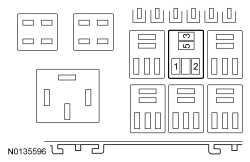 | Yes
REPAIR the circuit. No GO to Q17 . | ||||||||||||||||||||||||
| Q4 CHECK THE BLOWER MOTOR RELAY FUNCTIONALITY | |||||||||||||||||||||||||
| Yes
INSTALL a new blower motor relay. No GO to Q5 . | ||||||||||||||||||||||||
| Q5 CHECK THE BLOWER MOTOR RELAY COIL SUPPLY VOLTAGE | |||||||||||||||||||||||||
 | Yes
GO to Q6 . No VERIFY BJB fuse 89 (5A) is OK. If OK, REPAIR the circuit. If not OK, REFER to the Wiring Diagrams manual to identify the possible causes of the circuit short. | ||||||||||||||||||||||||
| Q6 CHECK THE BLOWER MOTOR RELAY COIL CONTROL CIRCUIT FOR AN OPEN | |||||||||||||||||||||||||
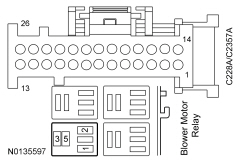
 | Yes
GO to Q17 . No REPAIR the circuit. | ||||||||||||||||||||||||
| Q7 CHECK THE BLOWER MOTOR OPERATION USING ACTIVE COMMANDS | |||||||||||||||||||||||||
| Yes
For 4.2 Inch (107mm) Screen, 4 or 6 Speakers, REFER to Section 415-00A Symptom Chart. For 8 Inch (203mm) Touchscreen, 7 Speakers, REFER to Section 415-00B Symptom Chart. For Sony® Sound, 8 Inch (203mm) Touchscreen, 12 Speakers, REFER to Section 415-00C Symptom Chart. No GO to Q8 . | ||||||||||||||||||||||||
| Q8 CHECK THE BLOWER MOTOR RELAY FUNCTIONALITY | |||||||||||||||||||||||||
| Yes
INSTALL a new blower motor relay. No GO to Q9 . | ||||||||||||||||||||||||
| Q9 CHECK FOR VOLTAGE AT THE BLOWER MOTOR RELAY SWITCH CONTACT | |||||||||||||||||||||||||
 | Yes
GO to Q10 . No VERIFY BJB fuse 18 (40A) is OK. If OK, REPAIR the circuit. If not OK, REFER to the Wiring Diagrams manual to identify the possible causes of the circuit short. | ||||||||||||||||||||||||
| Q10 CHECK VOLTAGE TO THE BLOWER MOTOR WITH THE BLOWER MOTOR RELAY BYPASSED | |||||||||||||||||||||||||

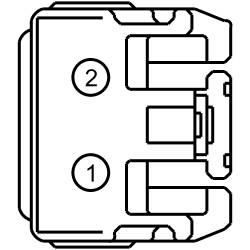 | Yes
DISCONNECT the fused jumper wire. CONNECT the motor relay. GO to Q11 . No REPAIR the circuit. | ||||||||||||||||||||||||
| Q11 CHECK THE BLOWER MOTOR SPEED CONTROL POWER CIRCUIT FOR VOLTAGE | |||||||||||||||||||||||||
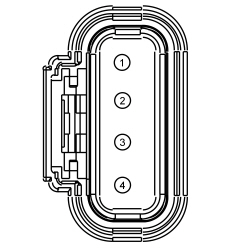 | Yes
GO to Q12 . No REPAIR the circuit. | ||||||||||||||||||||||||
| Q12 CHECK FOR BLOWER MOTOR FUNCTIONALITY WITH A TEST LIGHT IN PLACE OF THE BLOWER MOTOR | |||||||||||||||||||||||||
NOTICE: This step uses a test light to simulate normal circuit loads. Use only the test light recommended in the Special Tools table at the beginning of this section or equivalent. To avoid connector terminal damage, use the Flex Probe Kit for the test light probe connection to the vehicle. Do not use the test light probe directly on any connector.
 | Yes
INSTALL a new blower motor. REFER to Section 412-01 . No GO to Q13 . | ||||||||||||||||||||||||
| Q13 CHECK THE BLOWER MOTOR GROUND CIRCUIT FOR AN OPEN | |||||||||||||||||||||||||
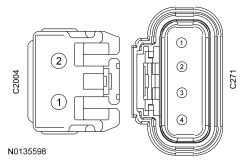 | Yes
GO to Q14 . No REPAIR the circuit. | ||||||||||||||||||||||||
| Q14 CHECK THE BLOWER MOTOR SPEED CONTROL GROUND CIRCUIT FOR AN OPEN | |||||||||||||||||||||||||
 | Yes
GO to Q15 . No REPAIR the circuit. | ||||||||||||||||||||||||
| Q15 CHECK THE BLOWER MOTOR SPEED CONTROL COMMAND CIRCUIT FOR A SHORT TO GROUND | |||||||||||||||||||||||||
 | Yes
GO to Q16 . No REPAIR the circuit. | ||||||||||||||||||||||||
| Q16 CHECK THE BLOWER MOTOR SPEED CONTROL COMMAND CIRCUIT FOR AN OPEN | |||||||||||||||||||||||||
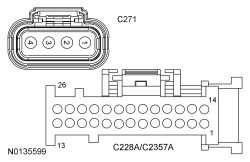
 | Yes
INSTALL a new blower motor speed control. REFER to Section 412-01 . If the concern is still present, GO to Q17 . No REPAIR the circuit. | ||||||||||||||||||||||||
| Q17 CHECK FOR CORRECT HVAC MODULE OPERATION | |||||||||||||||||||||||||
| Yes
CHECK OASIS for any applicable TSBs . If a TSB exists for this concern, DISCONTINUE this test and FOLLOW TSB instructions. If no TSB addresses this concern, INSTALL a new HVAC module. REFER to Section 412-01 . No The system is operating correctly at this time. The concern may have been caused by module connections. ADDRESS the root cause of any connector or pin issues. |
Pinpoint Test R: The Blower Motor Does Not Operate Correctly
Diagnostics in this manual assume a certain skill level and knowledge of Ford-specific diagnostic practices. Refer to Diagnostic Methods in Section 100-00 for information about these practices.
Refer to Wiring Diagrams Cell 54 , Manual Climate Control System for schematic and connector information.
Refer to Wiring Diagrams Cell 55 , Automatic Climate Control System for schematic and connector information.
Voltage is provided to the blower motor relay coil and switch contacts. When the blower motor relay coil receives a ground from the HVAC module, the relay coil is energized and voltage is delivered from the blower motor relay to the blower motor. A varying ground for the blower motor is provided from the blower motor speed control. Ground is provided for the blower motor speed control. The HVAC module provides a blower target speed signal to the blower motor speed control to control the blower speed. The actual blower speed signal is provided to the HVAC module from the blower motor speed control.
DTC Fault Trigger Conditions
| DTC | Description | Fault Trigger Conditions |
|---|---|---|
| B10B9:12 | Blower Control: Circuit Short to Battery | This CMDTC sets when the HVAC module senses excessive voltage on the blower motor control target speed signal circuit, indicating a short directly to voltage. |
| Test Step | Result / Action to Take | ||||||||||||
|---|---|---|---|---|---|---|---|---|---|---|---|---|---|
| R1 CHECK THE HVAC MODULE FOR DTCs | |||||||||||||
| Yes
GO to R7 . No GO to R2 . | ||||||||||||
| R2 CHECK THE BLOWER MOTOR OPERATION USING ACTIVE COMMANDS | |||||||||||||
| Yes
For 4.2 Inch (107mm) Screen, 4 or 6 Speakers, REFER to Section 415-00A Symptom Chart. For 8 Inch (203mm) Touchscreen, 7 Speakers, REFER to Section 415-00B Symptom Chart. For Sony® Sound, 8 Inch (203mm) Touchscreen, 12 Speakers, REFER to Section 415-00C Symptom Chart. No GO to R3 . | ||||||||||||
| R3 CHECK THE BLOWER MOTOR RELAY COIL SWITCH GROUND CIRCUIT FOR A SHORT TO GROUND | |||||||||||||
 | Yes
GO to R4 . No REPAIR the circuit. | ||||||||||||
| R4 CHECK THE BLOWER MOTOR VOLTAGE CIRCUIT FOR A SHORT TO VOLTAGE | |||||||||||||
 | Yes
GO to R5 . No GO to R6 . | ||||||||||||
| R5 CHECK FOR VOLTAGE AT THE BLOWER MOTOR WITH THE BLOWER MOTOR RELAY DISCONNECTED | |||||||||||||
 | Yes
REPAIR the circuit. No INSTALL a new blower motor relay. | ||||||||||||
| R6 CHECK THE BLOWER MOTOR SPEED CONTROLLER FUNCTIONALITY | |||||||||||||
| Yes
INSTALL a new blower motor speed controller. REFER to Section 412-01 . No GO to R8 . | ||||||||||||
| R7 CHECK THE BLOWER MOTOR SPEED CONTROL COMMAND CIRCUIT FOR A SHORT TO VOLTAGE | |||||||||||||
 | Yes
REPAIR the circuit. No GO to R8 . | ||||||||||||
| R8 CHECK FOR CORRECT HVAC MODULE OPERATION | |||||||||||||
| Yes
CHECK OASIS for any applicable TSBs . If a TSB exists for this concern, DISCONTINUE this test and FOLLOW TSB instructions. If no TSB addresses this concern, INSTALL a new HVAC module. REFER to Section 412-01 . No The system is operating correctly at this time. The concern may have been caused by module connections. ADDRESS the root cause of any connector or pin issues. |
Pinpoint Test S: The Auxiliary Blower Motor is Inoperative
Diagnostics in this manual assume a certain skill level and knowledge of Ford-specific diagnostic practices. Refer to Diagnostic Methods in Section 100-00 for information about these practices.
Refer to Wiring Diagrams Cell 52 , Auxiliary Climate Control for schematic and connector information.
The auxiliary blower motor relay coil receives a ground from the HVAC module. When the relay coil is energized, voltage is delivered from the relay to the auxiliary blower motor speed control and auxiliary blower motor. The auxiliary blower motor speed control is grounded. The HVAC module provides a PWM signal to the auxiliary blower motor speed control to control the blower speed. Ground for the motor is provided from the auxiliary blower motor speed control.
DTC Fault Trigger Conditions
| DTC | Description | Fault Trigger Conditions |
|---|---|---|
| B10B0:12 | Rear Blower Fan Relay: Circuit Short to Battery | This CMDTC sets when the HVAC module senses excessive voltage on the relay coil ground circuit, indicating a short to voltage. |
| B10B0:13 | Rear Blower Fan Relay: Circuit Open | This CMDTC sets when the HVAC module senses no voltage on the relay coil ground circuit, indicating an open. |
| B10BA:14 | Rear Blower Control: Circuit Short to Ground or Open | This CMDTC sets when the HVAC module senses no voltage on the blower motor PWM command circuit, indicating an open or a short directly to ground. |
| Test Step | Result / Action to Take | ||||||||||||||||||||||||
|---|---|---|---|---|---|---|---|---|---|---|---|---|---|---|---|---|---|---|---|---|---|---|---|---|---|
| S1 CHECK THE HVAC MODULE FOR DTCS | |||||||||||||||||||||||||
| Yes
For DTC B10B0:12, GO to S2 . For DTC B10B0:13, GO to S4 . For DTC B10BA:14, GO to S7 . No GO to S7 . | ||||||||||||||||||||||||
| S2 CHECK THE AUXILIARY BLOWER MOTOR RELAY FUNCTIONALITY | |||||||||||||||||||||||||
| Yes
INSTALL a new auxiliary blower motor relay. No GO to S3 . | ||||||||||||||||||||||||
| S3 CHECK THE AUXILIARY BLOWER MOTOR RELAY COIL CONTROL CIRCUIT FOR A SHORT TO VOLTAGE | |||||||||||||||||||||||||
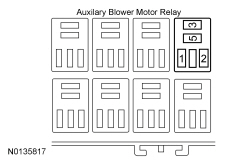 | Yes
REPAIR the circuit. No GO to S16 . | ||||||||||||||||||||||||
| S4 CHECK THE AUXILIARY BLOWER MOTOR RELAY FUNCTIONALITY | |||||||||||||||||||||||||
| Yes
INSTALL a new auxiliary blower motor relay. No GO to S5 . | ||||||||||||||||||||||||
| S5 CHECK THE AUXILIARY BLOWER MOTOR RELAY COIL SUPPLY VOLTAGE | |||||||||||||||||||||||||
 | Yes
GO to S6 . No VERIFY BJB fuse 93 (5A) is OK. If OK, REPAIR the circuit. If not OK, REFER to the Wiring Diagrams manual to identify the possible causes of the circuit short. | ||||||||||||||||||||||||
| S6 CHECK THE AUXILIARY BLOWER MOTOR RELAY COIL CONTROL CIRCUIT FOR AN OPEN | |||||||||||||||||||||||||

 | Yes
GO to S16 . No REPAIR the circuit. | ||||||||||||||||||||||||
| S7 CHECK THE AUXILIARY BLOWER MOTOR RELAY FUNCTIONALITY | |||||||||||||||||||||||||
| Yes
INSTALL a new auxiliary blower motor relay. No GO to S8 . | ||||||||||||||||||||||||
| S8 CHECK FOR VOLTAGE AT THE AUXILIARY BLOWER MOTOR RELAY SWITCH CONTACT | |||||||||||||||||||||||||
 | Yes
GO to S9 . No VERIFY BJB fuse 39 (30A) is OK. If OK, REPAIR the circuit. If not OK, REFER to the Wiring Diagrams manual to identify the possible causes of the circuit short. | ||||||||||||||||||||||||
| S9 CHECK VOLTAGE TO THE AUXILIARY BLOWER MOTOR WITH THE AUXILIARY BLOWER MOTOR RELAY BYPASSED | |||||||||||||||||||||||||

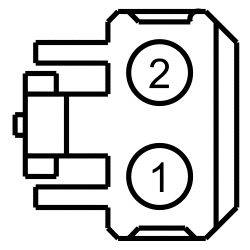 | Yes
Disconnect the fused jumper wire and connect the auxiliary blower motor relay. GO to S10 . No REPAIR the circuit. | ||||||||||||||||||||||||
| S10 CHECK THE AUXILIARY BLOWER MOTOR SPEED CONTROL POWER CIRCUIT FOR VOLTAGE | |||||||||||||||||||||||||
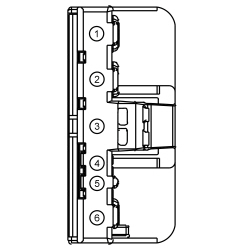 | Yes
GO to S11 . No REPAIR the circuit. | ||||||||||||||||||||||||
| S11 CHECK FOR AUXILIARY BLOWER MOTOR FUNCTIONALITY WITH A TEST LIGHT IN PLACE OF THE AUXILIARY BLOWER MOTOR | |||||||||||||||||||||||||
NOTICE: This step uses a test light to simulate normal circuit loads. Use only the test light recommended in the Special Tools table at the beginning of this section or equivalent. To avoid connector terminal damage, use the Flex Probe Kit for the test light probe connection to the vehicle. Do not use the test light probe directly on any connector.
 | Yes
INSTALL a new auxiliary blower motor. REFER to Section 412-02 . No GO to S12 . | ||||||||||||||||||||||||
| S12 CHECK THE AUXILIARY BLOWER MOTOR GROUND CIRCUIT FOR AN OPEN | |||||||||||||||||||||||||
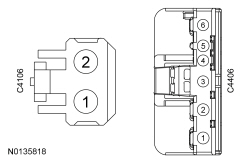 | Yes
GO to S13 . No REPAIR the circuit. | ||||||||||||||||||||||||
| S13 CHECK THE AUXILIARY BLOWER MOTOR SPEED CONTROL GROUND CIRCUIT FOR AN OPEN | |||||||||||||||||||||||||
 | Yes
GO to S14 . No REPAIR the circuit. | ||||||||||||||||||||||||
| S14 CHECK THE AUXILIARY BLOWER MOTOR SPEED CONTROL COMMAND CIRCUIT FOR A SHORT TO GROUND | |||||||||||||||||||||||||
 | Yes
GO to S15 . No REPAIR the circuit. | ||||||||||||||||||||||||
| S15 CHECK THE AUXILIARY BLOWER MOTOR SPEED CONTROL COMMAND CIRCUIT FOR AN OPEN | |||||||||||||||||||||||||
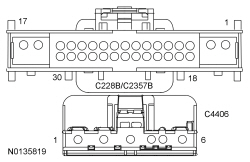
 | Yes
INSTALL a new auxiliary blower motor speed control. REFER to Section 412-02 . If the concern is still present, GO to S16 . No REPAIR the circuit. | ||||||||||||||||||||||||
| S16 CHECK FOR CORRECT HVAC MODULE OPERATION | |||||||||||||||||||||||||
| Yes
CHECK OASIS for any applicable TSBs . If a TSB exists for this concern, DISCONTINUE this test and FOLLOW TSB instructions. If no TSBs address this concern, INSTALL a new HVAC module. REFER to Section 412-01 . No The system is operating correctly at this time. The concern may have been caused by module connections. ADDRESS the root cause of any connector or pin issues. |
Pinpoint Test T: The Auxiliary Blower Motor Does Not Operate Correctly
Diagnostics in this manual assume a certain skill level and knowledge of Ford-specific diagnostic practices. Refer to Diagnostic Methods in Section 100-00 for information about these practices.
Refer to Wiring Diagrams Cell 52 , Auxiliary Climate Control for schematic and connector information.
The auxiliary blower motor relay coil receives a ground from the HVAC module. When the relay coil is energized, voltage is delivered from the relay to the auxiliary blower motor speed control and auxiliary blower motor. The auxiliary blower motor speed control is grounded. The HVAC module provides a PWM signal to the auxiliary blower motor speed control to control the blower speed. Ground for the motor is provided from the auxiliary blower motor speed control.
DTC Fault Trigger Conditions
| DTC | Description | Fault Trigger Conditions |
|---|---|---|
| B10BA:12 | Rear Blower Control: Circuit Short to Battery | This CMDTC sets when the HVAC module senses excessive voltage on the blower motor control PWM circuit for more than 20 milliseconds. |
| Test Step | Result / Action to Take | ||||||||||||
|---|---|---|---|---|---|---|---|---|---|---|---|---|---|
| T1 CHECK THE HVAC MODULE FOR DTCS | |||||||||||||
| Yes
GO to T4 . No GO to T2 . | ||||||||||||
| T2 CHECK THE AUXILIARY BLOWER MOTOR RELAY COIL CONTROL CIRCUIT FOR A SHORT TO GROUND | |||||||||||||
 | Yes
GO to T3 . No REPAIR the circuit. | ||||||||||||
| T3 CHECK THE AUXILIARY BLOWER MOTOR VOLTAGE CIRCUIT FOR A SHORT TO VOLTAGE | |||||||||||||
 | Yes
REPAIR the circuit. No GO to T4 . | ||||||||||||
| T4 CHECK THE AUXILIARY BLOWER MOTOR SPEED CONTROL COMMAND CIRCUIT FOR A SHORT TO VOLTAGE | |||||||||||||
 | Yes
REPAIR the circuit. No GO to T5 . | ||||||||||||
| T5 CHECK FOR CORRECT HVAC MODULE OPERATION | |||||||||||||
| Yes
CHECK OASIS for any applicable TSBs . If a TSB exists for this concern, DISCONTINUE this test and FOLLOW TSB instructions. If no TSBs address this concern, INSTALL a new HVAC module. REFER to Section 412-01 . No The system is operating correctly at this time. The concern may have been caused by module connections. ADDRESS the root cause of any connector or pin issues. |
Pinpoint Test U: The Auxiliary Temperature Control is Inoperative/Does Not Operate Correctly Using the Front/Rear Auxiliary Climate Controls
Diagnostics in this manual assume a certain skill level and knowledge of Ford-specific diagnostic practices. Refer to Diagnostic Methods in Section 100-00 for information about these practices.
Refer to Wiring Diagrams Cell 52 , Auxiliary Climate Control for schematic and connector information.
To rotate the auxiliary temperature blend door actuator, the HVAC module supplies voltage and ground to the auxiliary temperature blend door actuator through the door actuator motor circuits. To reverse the auxiliary temperature blend door actuator rotation, the HVAC module reverses the voltage and ground circuits.
The auxiliary temperature blend door actuator feedback resistor is supplied a 5-volt reference voltage and ground from the HVAC module. The HVAC module measures the resistance on the auxiliary temperature blend door actuator feedback circuit to determine the auxiliary temperature blend door actuator position by the position of the actuator feedback resistor wiper arm.
During an actuator calibration cycle, the HVAC module drives the auxiliary temperature blend door until the door reaches both internal stops in the HVAC case. If the auxiliary temperature blend door is temporarily obstructed or binding during a calibration cycle, the HVAC module may interpret this as the actual end of travel for the door. When this condition occurs and the HVAC module commands the actuator to its end of travel, the airflow may not be from the expected outlets.
DTC Fault Trigger Conditions
| DTC | Description | Fault Trigger Conditions |
|---|---|---|
| B10B7:11 | Rear Air Discharge Temperature: Circuit Short to Ground | This CMDTC sets when the HVAC module senses less than expected voltage on the actuator feedback circuit, indicating a short to ground. |
| B10B7:15 | Rear Air Discharge Temperature: Circuit Short to Battery or Open | This CMDTC sets when the HVAC module senses greater than expected voltage on the actuator feedback circuit, indicating an open circuit or a short to voltage. |
| B11E3:11 | Rear HVAC Damper Motor: Circuit Short to Ground | This CMDTC sets when the HVAC module senses a short to ground on an actuator motor circuit when voltage is applied to drive the motor. |
| B11E3:12 | Rear HVAC Damper Motor: Circuit Short to Battery | This CMDTC sets when the HVAC module senses a short to voltage on the actuator motor circuit when ground is applied to drive the motor. |
| B11E3:13 | Rear HVAC Damper Motor: Circuit Open | This CMDTC sets when the HVAC module senses an open on the actuator motor circuit when ground is applied to drive the motor. |
| Test Step | Result / Action to Take | ||||||||||||||||||||||||||||||||
|---|---|---|---|---|---|---|---|---|---|---|---|---|---|---|---|---|---|---|---|---|---|---|---|---|---|---|---|---|---|---|---|---|---|
| U1 CHECK THE HVAC MODULE FOR DTCS | |||||||||||||||||||||||||||||||||
| Yes
For DTC B11E3:11, GO to U2 . For DTC B11E3:12, GO to U3 . For DTC B11E3:13, GO to U5 . For DTC B10B7:11, GO to U6 . For DTC B10B7:15, GO to U8 . No GO to U2 . | ||||||||||||||||||||||||||||||||
| U2 CHECK THE AUXILIARY TEMPERATURE BLEND DOOR ACTUATOR MOTOR CIRCUITS FOR A SHORT TO GROUND | |||||||||||||||||||||||||||||||||
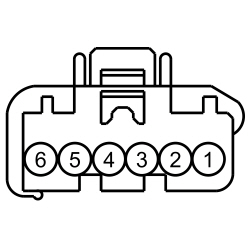 | Yes
GO to U4 . No REPAIR the circuit in question. | ||||||||||||||||||||||||||||||||
| U3 CHECK THE AUXILIARY TEMPERATURE BLEND DOOR ACTUATOR MOTOR CIRCUITS FOR A SHORT TO VOLTAGE | |||||||||||||||||||||||||||||||||
 | Yes
REPAIR the circuit in question. No GO to U4 . | ||||||||||||||||||||||||||||||||
| U4 CHECK THE AUXILIARY TEMPERATURE BLEND DOOR ACTUATOR MOTOR CIRCUITS FOR A SHORT TOGETHER | |||||||||||||||||||||||||||||||||
 | Yes
GO to U13 . No REPAIR the circuit. | ||||||||||||||||||||||||||||||||
| U5 CHECK THE AUXILIARY TEMPERATURE BLEND DOOR ACTUATOR MOTOR CIRCUITS FOR AN OPEN | |||||||||||||||||||||||||||||||||
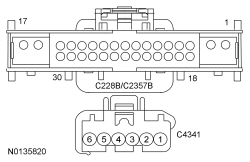
 | Yes
GO to U13 . No REPAIR the circuit in question. | ||||||||||||||||||||||||||||||||
| U6 CHECK THE AUXILIARY TEMPERATURE BLEND DOOR ACTUATOR FEEDBACK CIRCUIT FOR A SHORT TO GROUND | |||||||||||||||||||||||||||||||||
 | Yes
GO to U7 . No REPAIR the circuit. | ||||||||||||||||||||||||||||||||
| U7 CHECK THE SIGNAL RETURN CIRCUIT FOR A SHORT TO THE AUXILIARY TEMPERATURE BLEND DOOR ACTUATOR FEEDBACK CIRCUIT | |||||||||||||||||||||||||||||||||

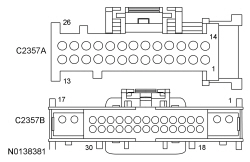 | Yes
GO to U13 . No REPAIR the circuits. | ||||||||||||||||||||||||||||||||
| U8 CHECK THE AUXILIARY TEMPERATURE BLEND DOOR ACTUATOR FEEDBACK CIRCUIT FOR A SHORT TO VOLTAGE | |||||||||||||||||||||||||||||||||
 | Yes
REPAIR the circuit. No GO to U9 . | ||||||||||||||||||||||||||||||||
| U9 CHECK THE AUXILIARY TEMPERATURE BLEND DOOR ACTUATOR REFERENCE VOLTAGE CIRCUIT FOR AN OPEN | |||||||||||||||||||||||||||||||||
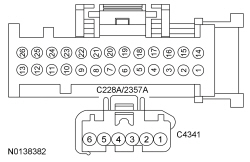
 | Yes
GO to U10 . No REPAIR the circuit. | ||||||||||||||||||||||||||||||||
| U10 CHECK THE AUXILIARY TEMPERATURE BLEND DOOR ACTUATOR REFERENCE VOLTAGE CIRCUIT FOR A SHORT TO THE FEEDBACK CIRCUIT | |||||||||||||||||||||||||||||||||

 | Yes
GO to U11 . No REPAIR the circuits. | ||||||||||||||||||||||||||||||||
| U11 CHECK THE AUXILIARY TEMPERATURE BLEND DOOR ACTUATOR FEEDBACK CIRCUIT FOR AN OPEN | |||||||||||||||||||||||||||||||||

 | Yes
GO to U12 . No REPAIR the circuit. | ||||||||||||||||||||||||||||||||
| U12 CHECK THE AUXILIARY TEMPERATURE BLEND DOOR ACTUATOR SIGNAL RETURN CIRCUIT FOR AN OPEN | |||||||||||||||||||||||||||||||||

 | Yes
GO to U13 . No REPAIR the circuit. | ||||||||||||||||||||||||||||||||
| U13 CHECK FOR CORRECT AUXILIARY TEMPERATURE BLEND DOOR ACTUATOR OPERATION | |||||||||||||||||||||||||||||||||
| Yes
INSTALL a new auxiliary temperature blend door actuator; REFER to Section 412-02 . If the concern is still present, GO to U14 . No The system is operating correctly at this time. The concern may have been caused by module connections. ADDRESS the root cause of any connector or pin issues. | ||||||||||||||||||||||||||||||||
| U14 MODULE ACTUATOR POSITION CALIBRATION | |||||||||||||||||||||||||||||||||
NOTE: The purpose of the module actuator position calibration is to allow the HVAC module to reinitialize and calibrate the actuator stop points. | Yes
CHECK OASIS for any applicable TSBs . If a TSB exists for this concern, DISCONTINUE this test and FOLLOW TSB instructions. If no TSBs address this concern, INSTALL a new HVAC module. REFER to Section 412-01 . No The system is now operating correctly at this time. The concern may have been caused by a foreign object in the HVAC case or temporary binding that restricted actuator door travel. CHECK any actuator external linkage. If condition recurs, INSPECT actuator linkage and door for binding and CHECK HVAC case for foreign objects. |
Pinpoint Test V: The Auxiliary Panel/Floor Mode Control Is Inoperative/Does Not Operate Correctly Using the Front/Rear Auxiliary Climate Controls
Refer to Wiring Diagrams Cell 52 , Auxiliary Climate Control for schematic and connector information.
To rotate the auxiliary mode door actuator, the HVAC module supplies voltage and ground to the auxiliary mode door actuator motor through the door actuator motor circuits. To reverse the auxiliary mode door actuator rotation, the HVAC module reverses the voltage and ground circuits.
The auxiliary mode door actuator feedback resistor is supplied a 5-volt reference voltage and ground from the HVAC module. The HVAC module measures the resistance on the auxiliary mode door actuator feedback circuit to determine the auxiliary mode door actuator position by the position of the actuator feedback resistor wiper arm.
During an actuator calibration cycle, the HVAC module drives the auxiliary mode door until the door reaches both internal stops in the HVAC case. If the auxiliary mode door is temporarily obstructed or binding during a calibration cycle, the HVAC module may interpret this as the actual end of travel for the door. When this condition occurs and the HVAC module commands the actuator to its end of travel, the airflow may not be from the expected outlets.
DTC Fault Trigger Conditions
| DTC | Description | Fault Trigger Conditions |
|---|---|---|
| B11E4:11 | Rear Air Distribution Damper Motor: Circuit Short to Ground | This CMDTC sets when the HVAC module senses a short to ground on an actuator motor circuit when voltage is applied to drive the motor. |
| B11E4:12 | Rear Air Distribution Damper Motor: Circuit Short to Battery | This CMDTC sets when the HVAC module senses a short to voltage on the actuator motor circuit when ground is applied to drive the motor. |
| B11E4:13 | Rear Air Distribution Damper Motor: Circuit Open | This CMDTC sets when the HVAC module senses an open on the actuator motor circuit when ground is applied to drive the motor. |
| B1B7D:11 | Rear Air Distribution Actuator: Circuit Short to Ground | This CMDTC sets when the HVAC senses less than expected voltage on the actuator feedback circuit, indicating a short to ground. |
| B1B7D:15 | Rear Air Distribution Actuator: Circuit Short to Battery or Open | This CMDTC sets when the HVAC senses greater than expected voltage on the actuator feedback circuit, indicating an open circuit or a short to voltage. |
| Test Step | Result / Action to Take | ||||||||||||||||||||||||||||||||
|---|---|---|---|---|---|---|---|---|---|---|---|---|---|---|---|---|---|---|---|---|---|---|---|---|---|---|---|---|---|---|---|---|---|
| V1 CHECK THE HVAC MODULE FOR DTCS | |||||||||||||||||||||||||||||||||
| Yes
For DTC B11E4:11, GO to V2 . For DTC B11E4:12, GO to V3 . For DTC B11E4:13, GO to V5 . For DTC B1B7D:11, GO to V6 . For DTC B1B7D:15, GO to V8 . No GO to V2 . | ||||||||||||||||||||||||||||||||
| V2 CHECK THE AUXILIARY MODE DOOR ACTUATOR MOTOR CIRCUITS FOR A SHORT TO GROUND | |||||||||||||||||||||||||||||||||
 | Yes
GO to V4 . No REPAIR the circuit in question. | ||||||||||||||||||||||||||||||||
| V3 CHECK THE AUXILIARY MODE DOOR ACTUATOR MOTOR CIRCUITS FOR A SHORT TO VOLTAGE | |||||||||||||||||||||||||||||||||
 | Yes
REPAIR the circuit in question. No GO to V4 . | ||||||||||||||||||||||||||||||||
| V4 CHECK THE AUXILIARY MODE DOOR ACTUATOR MOTOR CIRCUITS FOR A SHORT TOGETHER | |||||||||||||||||||||||||||||||||
 | Yes
GO to V13 . No REPAIR the circuits. | ||||||||||||||||||||||||||||||||
| V5 CHECK THE AUXILIARY MODE DOOR ACTUATOR MOTOR CIRCUITS FOR AN OPEN | |||||||||||||||||||||||||||||||||
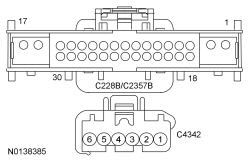
 | Yes
GO to V13 . No REPAIR the circuit in question. | ||||||||||||||||||||||||||||||||
| V6 CHECK THE AUXILIARY MODE DOOR ACTUATOR FEEDBACK CIRCUIT FOR A SHORT TO GROUND | |||||||||||||||||||||||||||||||||
 | Yes
GO to V7 . No REPAIR the circuit. | ||||||||||||||||||||||||||||||||
| V7 CHECK THE AUXILIARY MODE DOOR ACTUATOR SIGNAL RETURN CIRCUIT FOR A SHORT TO THE FEEDBACK CIRCUIT | |||||||||||||||||||||||||||||||||

 | Yes
GO to V13 . No REPAIR the circuits. | ||||||||||||||||||||||||||||||||
| V8 CHECK THE AUXILIARY MODE DOOR ACTUATOR FEEDBACK CIRCUIT FOR A SHORT TO VOLTAGE | |||||||||||||||||||||||||||||||||
 | Yes
REPAIR the circuit. No GO to V9 . | ||||||||||||||||||||||||||||||||
| V9 CHECK THE AUXILIARY MODE DOOR ACTUATOR REFERENCE VOLTAGE CIRCUIT FOR AN OPEN | |||||||||||||||||||||||||||||||||
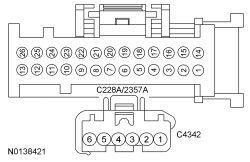
 | Yes
GO to V10 . No REPAIR the circuit. | ||||||||||||||||||||||||||||||||
| V10 CHECK THE AUXILIARY MODE DOOR ACTUATOR REFERENCE VOLTAGE CIRCUIT FOR A SHORT TO THE FEEDBACK CIRCUIT | |||||||||||||||||||||||||||||||||

 | Yes
GO to V11 . No REPAIR the circuits. | ||||||||||||||||||||||||||||||||
| V11 CHECK THE AUXILIARY MODE DOOR ACTUATOR FEEDBACK CIRCUIT FOR AN OPEN | |||||||||||||||||||||||||||||||||

 | Yes
GO to V12 . No REPAIR the circuit. | ||||||||||||||||||||||||||||||||
| V12 CHECK THE AUXILIARY MODE DOOR ACTUATOR RETURN CIRCUIT FOR AN OPEN | |||||||||||||||||||||||||||||||||

 | Yes
GO to V13 . No REPAIR the circuit. | ||||||||||||||||||||||||||||||||
| V13 CHECK FOR CORRECT AUXILIARY MODE DOOR ACTUATOR OPERATION | |||||||||||||||||||||||||||||||||
| Yes
INSTALL a new auxiliary mode door actuator, REFER to Section 412-02 Auxiliary Mode Door Actuator. If the concern is still present, GO to V14 . No The system is operating correctly at this time. The concern may have been caused by module connections. ADDRESS the root cause of any connector or pin issues. | ||||||||||||||||||||||||||||||||
| V14 MODULE ACTUATOR POSITION CALIBRATION | |||||||||||||||||||||||||||||||||
NOTE: The purpose of the module actuator position calibration is to allow the HVAC module to reinitialize and calibrate the actuator stop points. | Yes
CHECK OASIS for any applicable TSBs . If a TSB exists for this concern, DISCONTINUE this test and FOLLOW TSB instructions. If no TSBs address this concern, INSTALL a new HVAC module. REFER to Section 412-01 . No The system is now operating correctly at this time. The concern may have been caused by a foreign object in the HVAC case or temporary binding that restricted actuator door travel. CHECK any actuator external linkage. If condition recurs, INSPECT actuator linkage and door for binding and CHECK HVAC case for foreign objects. |
Pinpoint Test W: The Auxiliary Temperature, Panel/Floor Mode or Blower Motor Controls are Inoperative/Do Not Operate Correctly Using the Rear Auxiliary Climate Controls Only
Diagnostics in this manual assume a certain skill level and knowledge of Ford-specific diagnostic practices. Refer to Diagnostic Methods in Section 100-00 for information about these practices.
Refer to Wiring Diagrams Cell 52 , Auxiliary Climate Control for schematic and connector information.
The rear auxiliary control is supplied a 5-volt reference and ground from the HVAC module. When the auxiliary blower motor speed, airflow mode or temperature control is adjusted, the HVAC module reads the voltage from the rear auxiliary climate controls on the auxiliary blower motor speed, airflow mode and temperature control feedback circuits to determine the requested setting.
DTC Fault Trigger Conditions
| DTC | Description | Fault Trigger Conditions |
|---|---|---|
| B11EB:11 | Rear HVAC Temperature Control Input: Circuit Short to Ground | This CMDTC sets when the HVAC module senses a short to ground on the rear auxiliary climate controls temperature input circuit. |
| B11EB:15 | Rear HVAC Temperature Control Input: Circuit Short to Battery or Open | This CMDTC sets when the HVAC module senses an open circuit or a short to voltage on the rear auxiliary climate controls temperature input circuit. |
| B11EC:11 | Rear HVAC Blower Control Input: Circuit Short to Ground | This CMDTC sets when the HVAC module senses a short to ground on the rear auxiliary climate controls blower speed input circuit. |
| B11EC:15 | Rear HVAC Blower Control Input: Circuit Short to Battery or Open | This CMDTC sets when the HVAC module senses an open circuit or a short to voltage on the rear auxiliary climate controls blower speed input circuit. |
| B121D:11 | Rear HVAC Mode Control Input: Circuit Short to Ground | This CMDTC sets when the HVAC module senses a short to ground on the rear auxiliary climate controls airflow mode input circuit. |
| B121D:15 | Rear HVAC Mode Control Input: Circuit Short to Battery or Open | This CMDTC sets when the HVAC module senses an open circuit or a short to voltage on the rear auxiliary climate controls airflow mode input circuit. |
| Test Step | Result / Action to Take | ||||||||||||||||||||||||||||||||||||||||||||||||
|---|---|---|---|---|---|---|---|---|---|---|---|---|---|---|---|---|---|---|---|---|---|---|---|---|---|---|---|---|---|---|---|---|---|---|---|---|---|---|---|---|---|---|---|---|---|---|---|---|---|
| W1 CHECK THE CIRCUIT BETWEEN THE HVAC MODULE AND THE AUXILIARY CLIMATE CONTROL ASSEMBLY FOR A SHORT TO VOLTAGE | |||||||||||||||||||||||||||||||||||||||||||||||||
 | Yes
REPAIR the circuit in question. No GO to W2 . | ||||||||||||||||||||||||||||||||||||||||||||||||
| W2 CHECK THE CIRCUIT BETWEEN THE HVAC MODULE AND THE AUXILIARY CLIMATE CONTROL ASSEMBLY FOR A SHORT TO GROUND | |||||||||||||||||||||||||||||||||||||||||||||||||
 | Yes
GO to W3 . No REPAIR the circuit in question. | ||||||||||||||||||||||||||||||||||||||||||||||||
| W3 CHECK THE CIRCUIT BETWEEN THE HVAC MODULE AND THE AUXILIARY CLIMATE CONTROL ASSEMBLY FOR AN OPEN | |||||||||||||||||||||||||||||||||||||||||||||||||
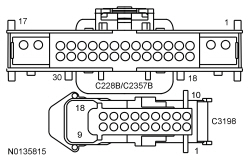
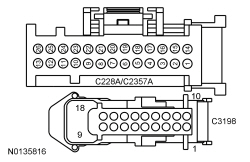 | Yes
INSTALL a new auxiliary climate control assembly. REFER to Section 412-02 Auxiliary Climate Control Assembly. TEST the system for normal operation. If the condition returns, GO to W4 . No REPAIR the circuit in question. | ||||||||||||||||||||||||||||||||||||||||||||||||
| W4 CHECK FOR CORRECT HVAC MODULE OPERATION | |||||||||||||||||||||||||||||||||||||||||||||||||
| Yes
CHECK OASIS for any applicable TSBs . If a TSB exists for this concern, DISCONTINUE this test and FOLLOW TSB instructions. If no TSBs address this concern, INSTALL a new HVAC module. REFER to Section 412-01 . No The system is operating correctly at this time. The concern may have been caused by module connections. ADDRESS the root cause of any connector or pin issues. |
Pinpoint Test X: The Air Conditioning Operation Is Erratic
Under normal operation when the A/C system is on, the engine cooling fan operates as commanded ON or OFF by the PCM to cool down the A/C condenser core.
| Test Step | Result / Action to Take |
|---|---|
| X1 CHECK THE ENGINE COOLING FAN (FAN_DSD) PCM PID OPERATION | |
| Yes
REFER to Refrigerant System Tests , procedure to DIAGNOSE the A/C system. No Install a new cooling fan REFER to Section 303-03 . |
Pinpoint Test Y: DTCs B1A69:11 and B1A69:15
Diagnostics in this manual assume a certain skill level and knowledge of Ford-specific diagnostic practices. Refer to Diagnostic Methods in Section 100-00 for information about these practices.
Refer to Wiring Diagrams Cell 54 , Manual Climate Control System for schematic and connector information.
Refer to Wiring Diagrams Cell 55 , Automatic Climate Control System for schematic and connector information.
The humidity sensor receives power from the HVAC reference voltage circuit. The sensor modifies voltage depending on the humidity in the air. The HVAC module translates the voltage signal into a humidity reading.
DTC Fault Trigger Conditions
| DTC | Description | Fault Trigger Conditions |
|---|---|---|
| B1A69:11 | Humidity Sensor: Circuit Short To Ground | The HVAC module senses less than expected voltage on the humidity sensor circuit, indicating a short to ground or sensor. |
| B1A69:15 | Humidity Sensor: Circuit Short To Battery or Open | The HVAC module senses greater than expected voltage on the humidity sensor circuit, indicating a short voltage or an open circuit or sensor. |
| Test Step | Result / Action to Take | ||||||||||||||||||||||||
|---|---|---|---|---|---|---|---|---|---|---|---|---|---|---|---|---|---|---|---|---|---|---|---|---|---|
| Y1 CHECK FOR HVAC MODULE DTCs | |||||||||||||||||||||||||
| Yes
GO to Pinpoint Test C . No GO to Y2 . | ||||||||||||||||||||||||
| Y2 CHECK FOR VOLTAGE TO THE IN-VEHICLE TEMPERATURE/HUMIDITY SENSOR | |||||||||||||||||||||||||
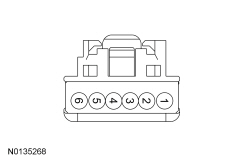 | Yes
For DTC B1A69:11 GO to Y3 . For DTC B1A69:15 GO to Y4 . No REPAIR the circuit. | ||||||||||||||||||||||||
| Y3 CHECK THE HUMIDITY SIGNAL CIRCUIT FOR A SHORT TO GROUND | |||||||||||||||||||||||||
 | Yes
GO to Y6 . No REPAIR the circuit. | ||||||||||||||||||||||||
| Y4 CHECK THE HUMIDITY SIGNAL CIRCUIT FOR AN OPEN CIRCUIT | |||||||||||||||||||||||||

 | Yes
GO to Y5 . No REPAIR the circuit. | ||||||||||||||||||||||||
| Y5 CHECK THE HUMIDITY SIGNAL CIRCUIT FOR A SHORT TO POWER | |||||||||||||||||||||||||
 | Yes
REPAIR the circuit. No GO to Y6 . | ||||||||||||||||||||||||
| Y6 ISOLATE THE IN-VEHICLE TEMPERATURE/HUMIDITY SENSOR | |||||||||||||||||||||||||
| Yes
GO to Y7 . No The cause of the concern was an inoperative in-vehicle temperature/humidity sensor. | ||||||||||||||||||||||||
| Y7 CHECK FOR CORRECT HVAC MODULE OPERATION | |||||||||||||||||||||||||
| Yes
CHECK OASIS for any applicable TSBs . If a TSB exists for this concern, DISCONTINUE this test and FOLLOW TSB instructions. If no TSB addresses this concern, INSTALL a new HVAC module. REFER to Section 412-01 . No The system is operating correctly at this time. The concern may have been caused by module connections. ADDRESS the root cause of any connector or pin issues. |
Pinpoint Test Z: DTC P06A0
Diagnostics in this manual assume a certain skill level and knowledge of Ford-specific diagnostic practices. Refer to Diagnostic Methods in Section 100-00 for information about these practices.
Refer to Wiring Diagrams Cell 54 , Manual Climate Control System for schematic and connector information.
Refer to Wiring Diagrams Cell 55 , Automatic Climate Control System for schematic and connector information.
The externally controlled variable displacement compressor is electronically controlled by the PCM. The PCM pulse width modulates the ground to the externally controlled variable displacement compressor to change the displacement of the A/C compressor.
DTC Fault Trigger Conditions
| DTC | Description | Fault Trigger Conditions |
|---|---|---|
| P06A0 | Variable A/C Compressor Control Circuit | The PCM senses greater than expected voltage on the sensor feedback circuit, indicating a short to voltage or an open circuit or sensor. |
| Test Step | Result / Action to Take | ||||||||||||||||||||||||
|---|---|---|---|---|---|---|---|---|---|---|---|---|---|---|---|---|---|---|---|---|---|---|---|---|---|
| Z1 CHECK FOR VOLTAGE TO THE A/C COMPRESSOR | |||||||||||||||||||||||||
 | Yes
GO to Z2 . No VERIFY the BJB fuse 70 (15A) is OK. If OK, REPAIR the circuit. If not OK, REFER to the Wiring Diagrams manual to identify the possible causes of the circuit short. | ||||||||||||||||||||||||
| Z2 CHECK THE A/C COMPRESSOR DISPLACEMENT CONTROL VALVE CIRCUIT FOR A SHORT TO GROUND | |||||||||||||||||||||||||
 | Yes
GO to Z3 . No REPAIR the circuit. | ||||||||||||||||||||||||
| Z3 CHECK THE A/C COMPRESSOR DISPLACEMENT CONTROL VALVE CIRCUIT FOR A SHORT TO POWER | |||||||||||||||||||||||||
 | Yes
REPAIR the circuit. No GO to Z4 . | ||||||||||||||||||||||||
| Z4 CHECK THE A/C COMPRESSOR DISPLACEMENT CONTROL VALVE CIRCUIT FOR AN OPEN | |||||||||||||||||||||||||
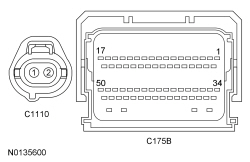
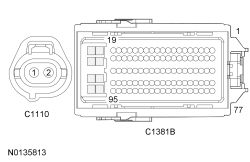 | Yes
INSTALL a new A/C compressor, REFER to Section 412-01 . CLEAR the DTC and REPEAT the self-test. If the DTC returns, GO to Z5 . No REPAIR the circuit. | ||||||||||||||||||||||||
| Z5 CHECK FOR CORRECT PCM OPERATION | |||||||||||||||||||||||||
| Yes
CHECK OASIS for any applicable TSBs . If a TSB exists for this concern, DISCONTINUE this test and FOLLOW TSB instructions. If no TSB addresses this concern, INSTALL a new PCM. REFER to Section 303-14 . No The system is operating correctly at this time. The concern may have been caused by module connections. ADDRESS the root cause of any connector or pin issues. |
Pinpoint Test AA: DTC U0140:00
Diagnostics in this manual assume a certain skill level and knowledge of Ford-specific diagnostic practices. Refer to Diagnostic Methods in Section 100-00 for information about these practices.
DTC Fault Trigger Conditions
| DTC | Description | Fault Trigger Conditions |
|---|---|---|
| U0140:00 | Lost Communication With Body Control Module: No Sub-Type Information | This CMDTC sets in the HVAC module if data messages received from the BCM over the HS-CAN are missing for 5 seconds or more. For a complete list of all network messages, refer to Section 418-00 . |
| Test Step | Result / Action to Take |
|---|---|
| AA1 VERIFY THE CUSTOMER CONCERN | |
| Yes
GO to AA2 . No The system is operating normally at this time. The DTC may have been set due to high network traffic or an intermittent fault condition. |
| AA2 CHECK THE COMMUNICATION NETWORK | |
| Yes
GO to AA3 . No REFER to Section 418-00 . |
| AA3 RETRIEVE THE RECORDED DTCs FROM THE BCM SELF-TEST | |
| Yes
REFER to Section 419-10 DTC Chart: Body Control Module (BCM). No GO to AA4 . |
| AA4 RETRIEVE THE RECORDED DTCs FROM THE HVAC MODULE SELF-TEST | |
| Yes
GO to Pinpoint Test g . No GO to AA5 . |
| AA5 RECHECK THE HVAC MODULE DTCs | |
NOTE: If new modules were installed prior to the DTC being set, the module configuration may be incorrectly set during the PMI or the PMI may not have been carried out. | Yes
If the vehicle is equipped with a DSM , GO to AA6 . Otherwise, GO to AA7 . No The system is operating correctly at this time. The DTC may have been set due to high network traffic or an intermittent fault condition. |
| AA6 CHECK FOR DTC U0140:00 SET IN OTHER MODULES | |
| Yes
GO to AA7 . No GO to AA8 . |
| AA7 CHECK FOR CORRECT BCM OPERATION | |
| Yes
CHECK OASIS for any applicable TSBs . If a TSB exists for this concern, DISCONTINUE this test and FOLLOW TSB instructions. If no TSB addresses this concern, INSTALL a new BCM . REFER to Section 419-10 Body Control Module (BCM) - with Intelligent Access (IA) or REFER to Body Control Module (BCM) - without Intelligent Access (IA). No The system is operating correctly at this time. The concern may have been caused by module connections. ADDRESS the root cause of any connector or pin issues. |
| AA8 CHECK FOR CORRECT HVAC MODULE OPERATION | |
| Yes
CHECK OASIS for any applicable TSBs . If a TSB exists for this concern, DISCONTINUE this test and FOLLOW TSB instructions. If no TSB addresses this concern, INSTALL a new HVAC module. REFER to Section 412-01 . No The system is operating correctly at this time. The concern may have been caused by module connections. ADDRESS the root cause of any connector or pin issues. |
Pinpoint Test AB: DTCs B1A61:15, B1A63:15 and B1A64:15
Diagnostics in this manual assume a certain skill level and knowledge of Ford-specific diagnostic practices. Refer to Diagnostic Methods in Section 100-00 for information about these practices.
Refer to Wiring Diagrams Cell 54 , Manual Climate Control System for schematic and connector information.
Refer to Wiring Diagrams Cell 55 , Automatic Climate Control System for schematic and connector information.
The in-vehicle temperature/humidity sensor receives a ground from the HVAC module. The sensor varies its resistance with the temperature. As the temperature rises, the resistance falls. As the temperature falls the resistance rises. The HVAC module measures this resistance to determine the temperature at the sensor. The autolamp/sunload sensor is grounded. As the light applied to the sensor changes, the HVAC module detects the change through the RH and LH feedback circuits.
The HVAC module internally ties the in-vehicle temperature/humidity sensor and the LH and RH autolamp/sunload sensor feedback short to voltage diagnostics together. In the event any of the 3 feedback circuits are shorted to voltage all three DTCs set.
DTC Fault Trigger Conditions
| DTC | Description | Fault Trigger Conditions |
|---|---|---|
| B1A61:15 | Cabin Temperature Sensor: Circuit Short to Battery or Open | This CMDTC sets when the HVAC module senses greater than expected voltage on the sensor feedback circuit, indicating a short to voltage or an open circuit or sensor. |
| B1A63:15 | Right Solar Sensor: Circuit Short to Battery or Open | This CMDTC sets when the HVAC module senses greater than expected voltage on the RH sensor feedback circuit, indicating a short to voltage or an open circuit or sensor. |
| B1A64:15 | Left Solar Sensor: Circuit Short to Battery or Open | This CMDTC sets when the HVAC module senses greater than expected voltage on the LH sensor feedback circuit, indicating a short to voltage or an open circuit or sensor. |
| Test Step | Result / Action to Take | ||||||||||||||||||||||||||||||||||||||||
|---|---|---|---|---|---|---|---|---|---|---|---|---|---|---|---|---|---|---|---|---|---|---|---|---|---|---|---|---|---|---|---|---|---|---|---|---|---|---|---|---|---|
| AB1 CHECK THE IN-VEHICLE TEMPERATURE/HUMIDITY SENSOR FEEDBACK CIRCUIT FOR A SHORT TO VOLTAGE | |||||||||||||||||||||||||||||||||||||||||

 | Yes
REPAIR the circuit in question. No GO to AB2 . | ||||||||||||||||||||||||||||||||||||||||
| AB2 CHECK FOR CORRECT HVAC MODULE OPERATION | |||||||||||||||||||||||||||||||||||||||||
| Yes
CHECK OASIS for any applicable TSBs . If a TSB exists for this concern, DISCONTINUE this test and FOLLOW TSB instructions. If no TSB addresses this concern, INSTALL a new HVAC module. REFER to Section 412-01 . No The system is operating correctly at this time. The concern may have been caused by module connections. ADDRESS the root cause of any connector or pin issues. |
Component Tests
Air Inlet Door Actuator
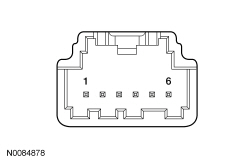
| Actuator Pins | Approx. Resistance |
|---|---|
| 5 and 6 | 55-69 ohms |
Blend Door Actuator — DATC

| Actuator Pins | Approx. Resistance |
|---|---|
| 1 and 3 | 3,040-4,560 ohms |
| 1 and 2 | 120-4,380 ohms |
| 2 and 3 | 120-4,380 ohms |
| 5 and 6 | 81-97 ohms |
Blend Door Actuator — EMTC

| Actuator Pins | Approx. Resistance |
|---|---|
| 1 and 3 | 3,040-4,560 ohms |
| 1 and 2 | 120-4,380 ohms |
| 2 and 3 | 120-4,380 ohms |
| 5 and 6 | 55-68 ohms |
Defrost/Panel/Floor Mode Door Actuator
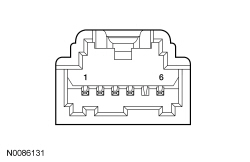
| Actuator Pins | Approx. Resistance |
|---|---|
| 2 and 3 | 2,775-4,625 ohms |
| 2 and 4 | 188-4,313 ohms |
| 3 and 4 | 188-4,313 ohms |
| 1 and 6 | 43-56 ohms |
Evaporator Temperature Sensor
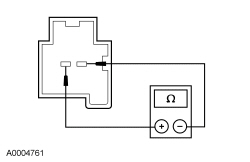
| Ambient Temperature | Approximate Resistance |
|---|---|
| -20°C (-4°F) | 276,959ohms |
| -5°C (23°F) | 123,458 ohms |
| 0°C (32°F) | 95,851 ohms |
| 5°C (41°F) | 74,940 ohms |
| 10°C (50°F) | 59,016 ohms |
| 15°C (59°F) | 46,797 ohms |
| 20°C (68°F) | 37,340 ohms |
| 25°C (77°F) | 30,000 ohms |
| 40°C (104°F) | 16,113 ohms |
| 60°C (140°F) | 7,548 ohms |
| 100°C (212°F) | 2,080 ohms |
| 120°C (248°F) | 1,191 ohms |
In-Vehicle Temperature/Humidity Sensor
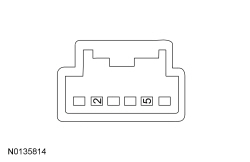
| Pins | Ambient Temperature | Approximate Resistance |
|---|---|---|
| Component side pin 2 to 5 | -40°C (-40°F) | 901,490 ohms |
| -15°C (5°F) | 208,450 ohms | |
| 0°C (32°F) | 95,560 ohms | |
| 15°C (59°F) | 46,750 ohms | |
| 25°C (77°F) | 30,000 ohms | |
| 35°C (95°F) | 19,720 ohms | |
| 60°C (140°F) | 7,592 ohms | |
| 85°C (185°F) | 3,286 ohms |
Auxiliary Temperature Door Actuator

| Actuator Pins | Approx. Resistance |
|---|---|
| 1 and 3 | 3,700-5,700 ohms |
| 1 and 2 | 150-5,700 ohms |
| 2 and 3 | 150-5,700 ohms |
| 5 and 6 | 28-44 ohms |
Auxiliary Mode Door Actuator

| Actuator Pins | Approx. Resistance |
|---|---|
| 1 and 3 | 3,700-5,700 ohms |
| 1 and 2 | 150-5,700 ohms |
| 2 and 3 | 150-5,700 ohms |
| 5 and 6 | 28-44 ohms |
Heater Core
NOTE: Testing of returned heater cores reveals that a large percentage of heater cores are good and did not require the installation of a new heater core. If a heater core leak is suspected, the heater core must be tested by following the plugged heater core component test before the heater core pressure test. Carry out a system inspection by checking the heater system thoroughly as follows:
Inspect for evidence of coolant leakage at the heater hose to heater core attachments. A coolant leak in the heater hose could follow the heater core tube to the heater core and appear as a leak in the heater core.NOTE: Spring-type clamps are installed as original equipment. Installation and overtightening of non-specified clamps can cause leakage at the heater hose connection and damage the heater core.
Check the integrity of the heater hose clamps.Heater Core — Plugged
Heater Core — Pressure Test
Use the Pressure Test Kit to carry out the pressure test.
NOTE: Due to space limitations, a bench test may be necessary for pressure testing.
Drain the coolant from the cooling system.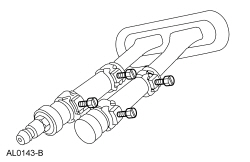
Heater Core — Bench Test
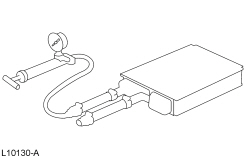
Evaporator/Condenser Core — On-Vehicle Leak Test
NOTE: The automatic shut-off valves on some gauge set hoses do not open when connected to the test fittings. If available, use hoses without shut-off valves. If hoses with shut-off valves are used, make sure the valve opens when attached to the test fittings or install an adapter that activates the valve. The test is not valid if the shut-off valve does not open.
Connect the red and blue hoses from the R-134a Manifold Gauge Set to the test fittings on the evaporator or condenser core. Connect the yellow hose to a known good vacuum pump.A/C Compressor — External Leak Test